There are many different types of tuna but they can all be caught with similar fishing techniques. Trolling, chunking, jigging, and using live bait are the four ways tuna are caught by sport fishermen. In the Atlantic ocean tuna species include yellowfin tuna, Atlantic bluefin tuna, blackfin tuna, bigeye tuna, skipjack tuna, and little tunny. In the pacific ocean, there are pacific bluefin tuna, yellowfin tuna, bigeye tuna, albacore tuna, black skipjack tuna, pacific bonito, and frigate mackerel.
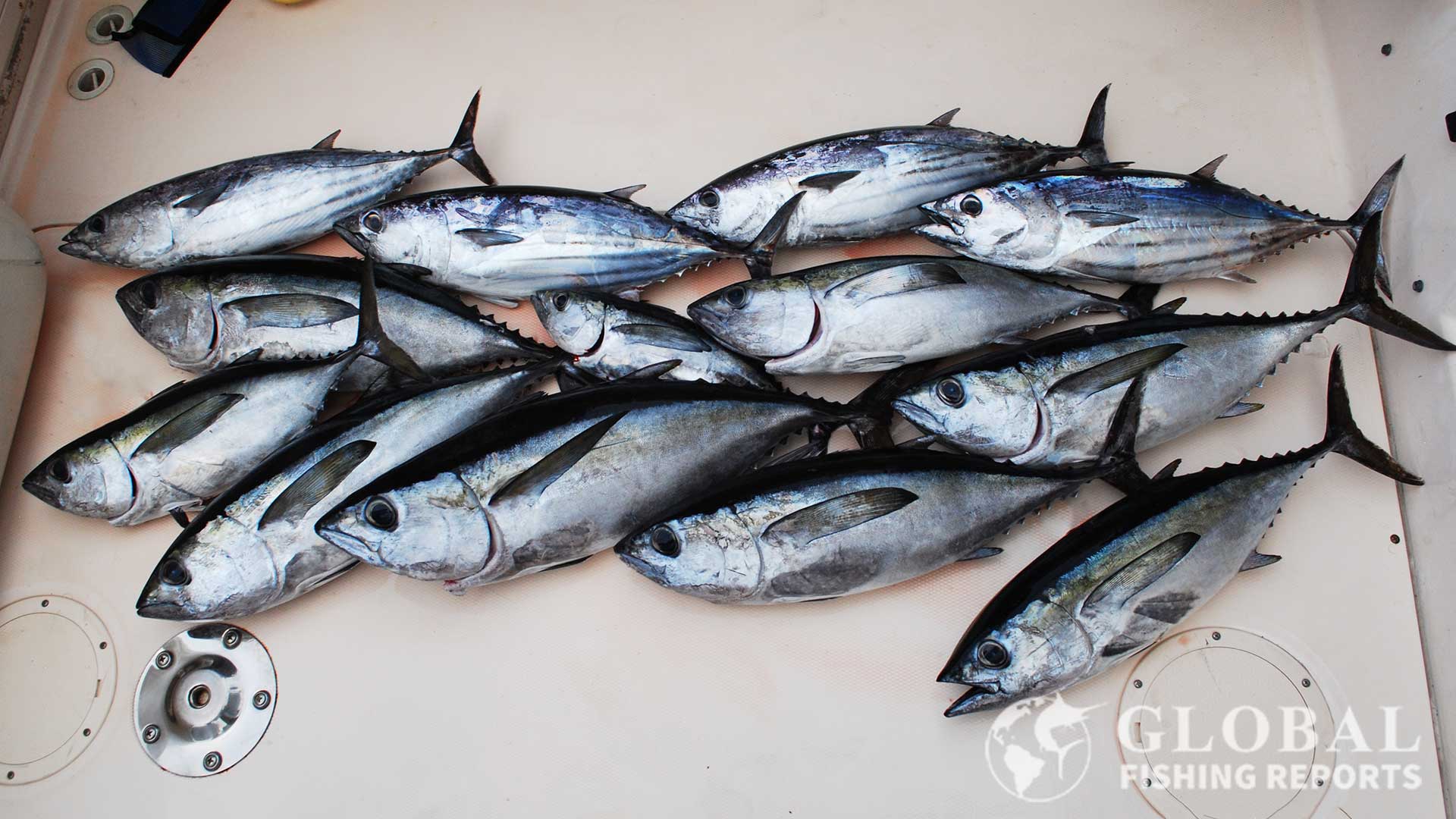
Tuna are a schooling fish that often feed on baitfish, shrimp, and squid. Some species of tuna migrate large distances and a highly migratory species permit is needed. All bluefin tuna catches most also submit a catch report online within 24 hours.
Blackfin tuna can be caught in Florida year-round and is one of the most consistent offshore fish species to catch. The size of fish can vary from 1 pound up to 40 pounds. Blackfin tuna and Mahi-mahi are my two favorite fish to eat. Tuna can be made into sashimi, sushi or tuna steaks that can be seared or cooked through. I am in the minority of people that like to eat tuna steaks that are cooked through.
When fishing for tuna it is also common to catch sailfish, marlin, mahi-mahi, and wahoo. This makes fishing for tuna very exciting. When the fishing pole gets bit you never know for sure what type of fish is on the line. Tuna are typically caught from the edge of the reef in about 100 feet of water all the way out to 1000+ feet of water in the Gulf Stream.
Finding Tuna Offshore
Tuna are often concentrated around large schools of bait. If the fish finder is marking bait, fish are breaking on the surface or birds are diving offshore there is a good chance tuna will be around! The general strategy of tuna fishing is to head for ledges, canyons, or humps and look for activity along the way.
If you are just starting out with offshore fishing it is important to get good information about the basic fishing strategies. Determining the best techniques, troll speeds, and locations is all-important to get right for a successful fishing trip. Hopefully, this article helps anyone that wants to catch their first tuna or catch lots of tuna do just that.
Trolling for Tuna
Trolling is the most common method used by sport fishermen to catch tuna. The average troll speed for tuna is 7-10 miles per hour. When trolling it is important to run lures pretty far back away from the boat, typically 100-500 feet behind the boat. This distance gives tuna time to spot the lure without being spooked by the boat.
Using fishing binoculars to spot diving birds is crucial. Schools of tuna push bait up near the surface, attracting birds. When birds are found, it’s often a good place to catch tuna. Don’t run and gun to each set of tuna as you can push them down deep where trolling methods are not effective. At trolling speed, try to aim just in front of where the tuna are headed. Dragging the baits close by and in front of the school will often result in multiple tuna being caught.
If you have a good spread of lures and do not catch fish, check the baits for weeds. Also, try changing the trolling speed or making s-turns. A change in troll speeds can often trigger bites.
Trolling Lure: Billy Bait Mini Turbo Slammer
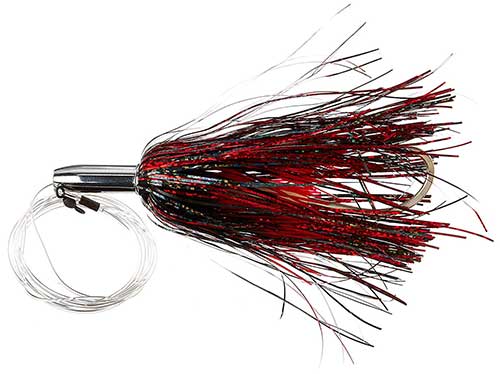
Buy from Amazon
Shop Bass Pro Shops
The Billy Baits Mini Turbo Slammer is 5-½ inches long and weighs 5/8 ounce. Color options include red-black, pearl-pink shimmer, pink-silver, and purple-blue mylar. These come rigged on a 6-foot 100-pound grand slam mono leader with a 7/0 Mustad hook. The bullet head is nickel-plated with a high flash mylar skirt. The mini turbo slammer works great without bait and can be trolled from 2-20 knots.
This red and black Billy Bait is the best lure I know of for blackfin tuna, skipjack tuna, and false albacore tuna! Tuna are often not super picky on lure choice but if only one pole gets a bite it is usually the black and red Billy Bait. Usually, when trolling over a school of tuna all the poles on the boat get bites within a few seconds. When targeting tuna this is a must-have lure. The mylar skirt with this color combo seems to be irresistible to tuna.
Tuna are often feeding on small bait and this lure works when larger baits are not catching fish. If the billy bait is not catching fish try speeding up, putting the lure further back, and check the lure for weeds. Typical troll speeds for tuna are 7-10 miles per hour. Mahi-mahi will hit bait about 10 feet behind the boat but tuna typically do not. I like to run the baits 100-500 feet behind the boat.
This lure will catch tuna under about 25 pounds how it comes rigged. If it is being used to catch large tuna with high drag I would recommend using 2 extra strong hooks. Often times due to predator fish like sharks being around the tuna need to be reeled in quickly. Some days my strategy is basically to winch the tuna in to prevent it from being eaten by sharks. I have seen bigger tuna, marlin, and other large fish eat the tuna that was being reeled in. The standard Mustad 3407 hook too often straightens out when catching these larger fish. Any hook can straighten so make sure the drag is properly set with a pull-scale on all the conventional reels.
In the video below I show how to catch blackfin tuna while trolling.
Trolling Lure: Captain’s Choice Chrome Head Mylar Skirt
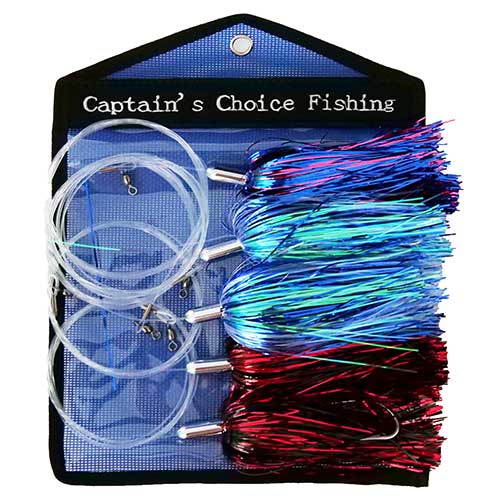
Buy from Amazon
Captain’s Choice Fishing chrome head mylar skirt lures are 6 inches in length and weigh 5/8 of an ounce. These come in colors of black/red, blue/white, and blue/pink.
When trolling for blackfin tuna, skipjack tuna, or bonita in Florida these are my go-to trolling lure. The leader line is Ande premium monofilament which is made in Germany. These lures are very similar to the Billy Bait lure but are typically found at a lower cost. Both lures are well made with a crimp protector sleeve. These are typically fished without bait and are very popular offshore lures to use when fishing in Florida.
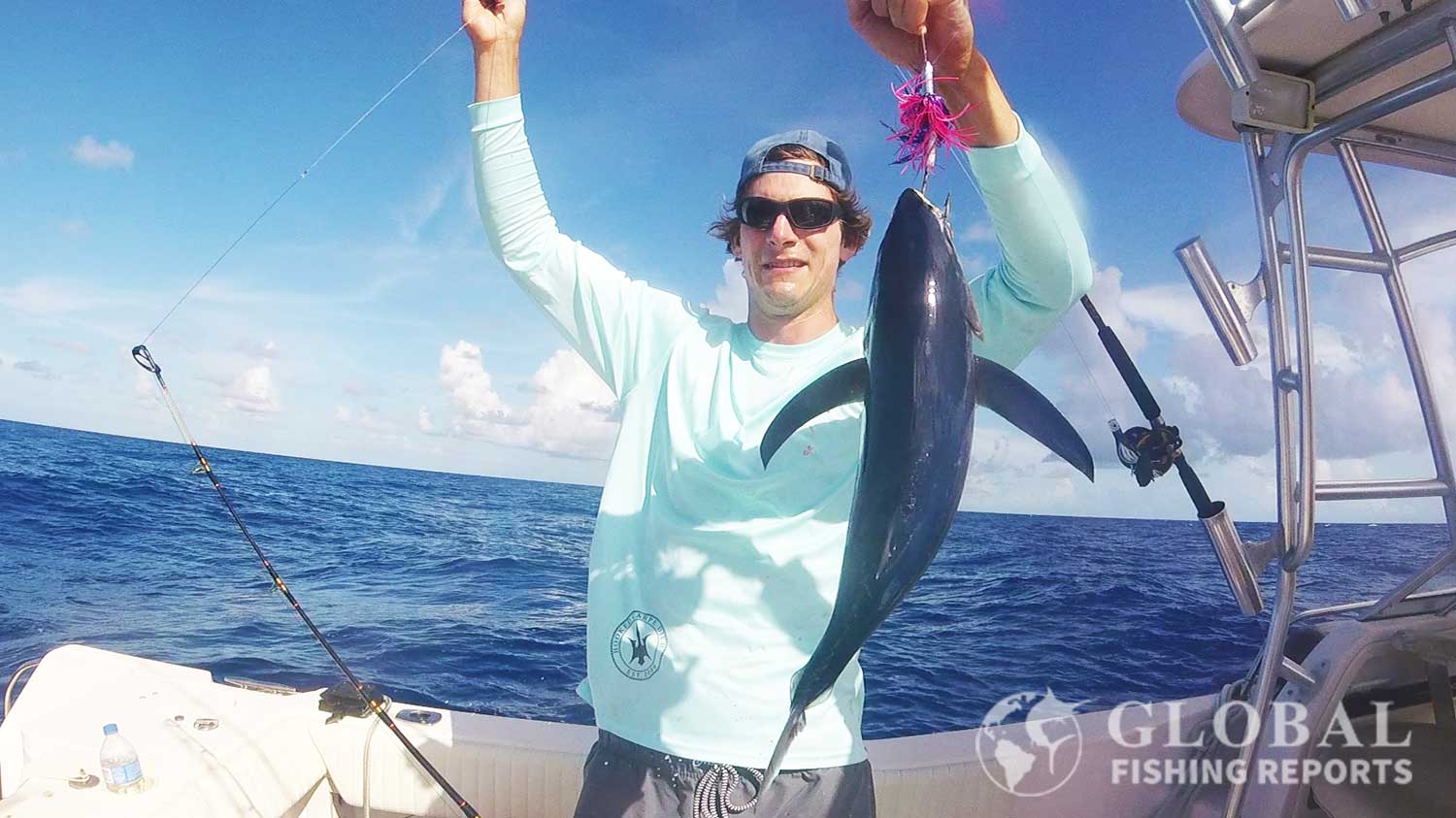
In the picture above I am holding a blackfin tuna that was caught on a pink and blue Billy Bait. This fish was caught trolling in the Florida Keys.
Trolling Lure: 6-inch Classic Offshore
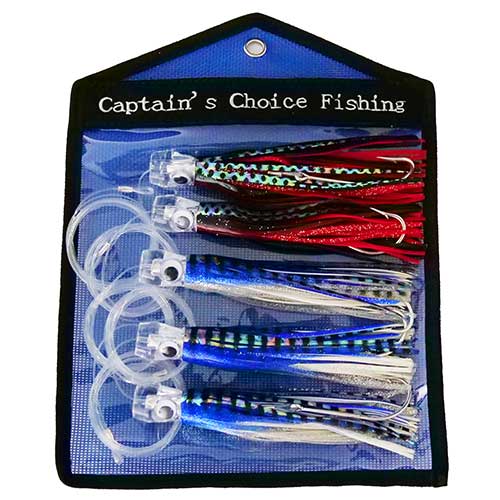
Buy from Amazon
These classic trolling lures are 6 inches in length. Red and black and blue and white are both awesome colors for blackfin tuna. If you are not sure what lure to troll this is a great option as it works to catch almost every species offshore. For tuna, it is good to set the mid-lures about 50 yards back and far lures about 100-yards behind the boat.
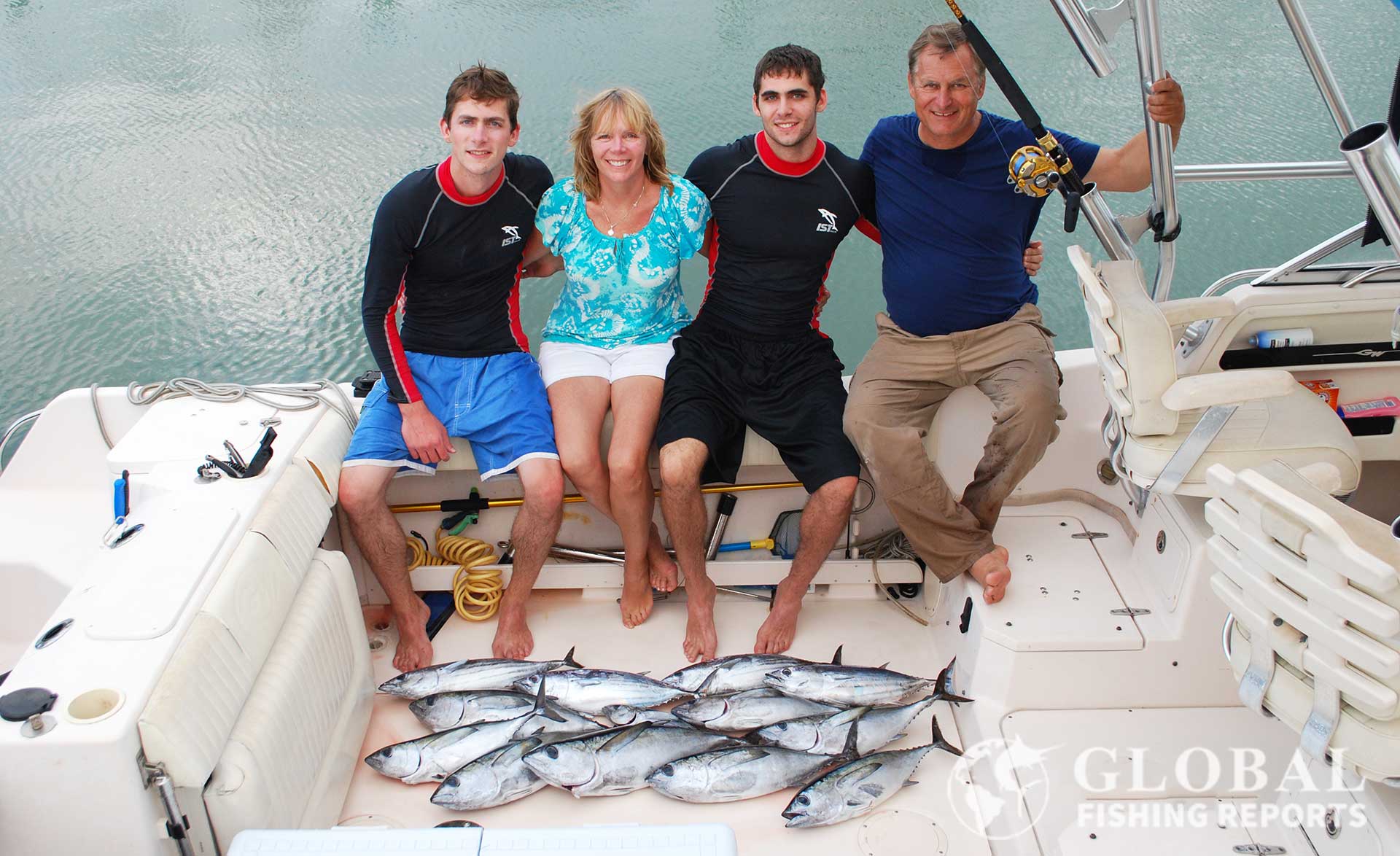
Trolling Lure: Tuna Bullet Daisy Chain

This tuna bullet daisy chain has three 4.5-inch teasers with the main lure being about 7-inches long. A 9-foot 150-pound test leader line is used with an 8/0 Mustad hook. Inline beads are used to space the hook at the end of the skirt. A stiff hooks protector is used to cover the eye of the hook and the crimp. This same lure also comes in blue-pink and yellow-orange green. However, the black and red is my favorite color for tuna. Bass Pros Shops Jaw Lures Daisy chain is another basic squid daisy chain that will work well for tuna.
At least one daisy chain should always be used when trolling offshore. Most often it is set in the shotgun position which is far out and straight out the back. Daisy chains can also be custom-made with egg weights or beads in the squid teasers. Lighter daisy chains with beads are less likely to pick up weeds but heaver daisy chains are more visible to the fish underwater. For this reason, it is good to have multiple daisy chain rigs ready to go for different conditions.
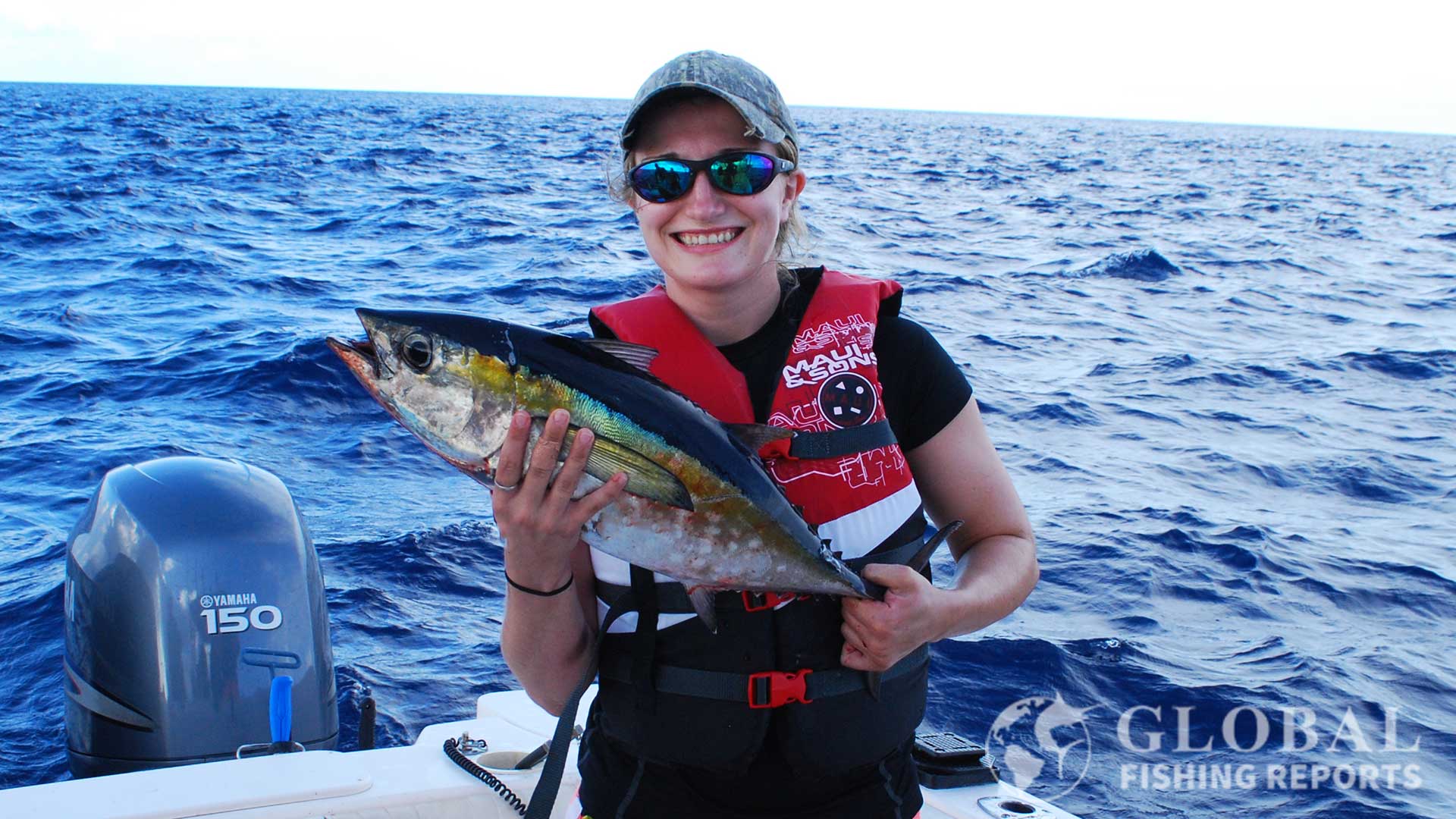
In the picture, Kristen is holding a blackfin tuna. This was caught while trolling in the Florida Keys.
Trolling Lure: Stubby Bubbler Tuna Lure
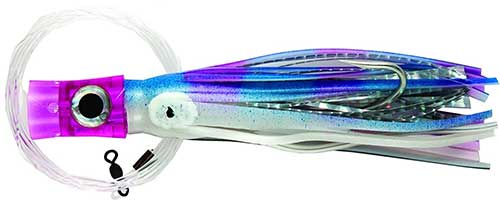
Buy from Amazon
Shop Bass Pro Shops
This C and H stubby bubbler comes in pink or purple, blue, white and has silver mylar within the skirt. The lure is 5 1/2-inches in length. Stubby bubblers come in a variety of other colors including, pink, blue-pink silver mylar, white-pink mylar, and black-red pear mylar.
Stubby bubblers are a versatile offshore trolling bait that will catch marlin, sailfish, mahi-mahi, and tuna. The only difference when targeting tuna is to put the lure a little further back, 100-300 feet is a good distance. When the lure is further back it will still create awesome bubble trails. This is a small bait that works well without strip bait or ballyhoo.
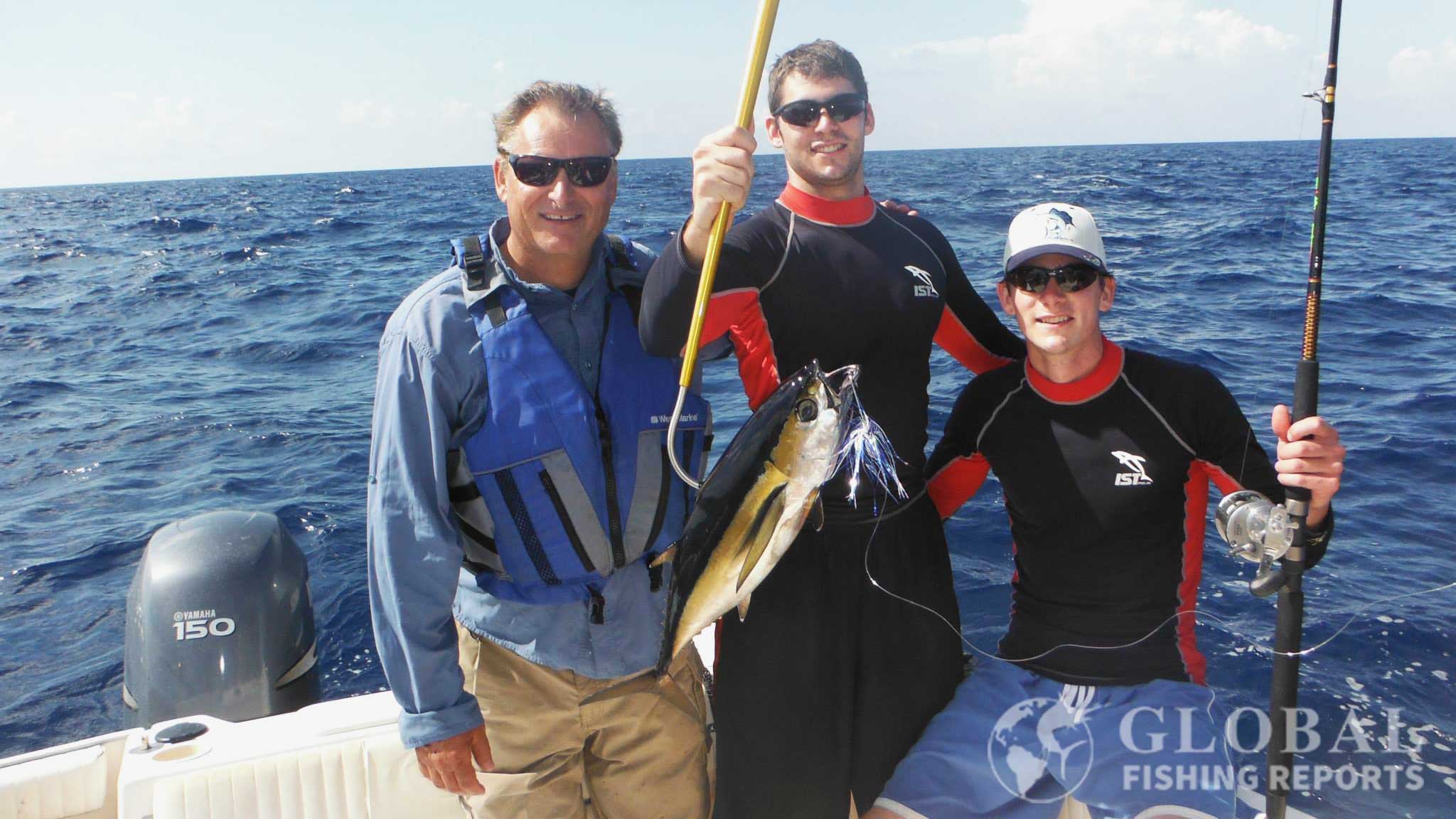
In the picture, my day brother and I are fishing in the Florida Keys. The blackfin tuna was caught on a blue and white Billy Bait while trolling.
Trolling Lure: Boone Gatlin-Jet Tuna Lure

Buy from Amazon
Shop Bass Pro Shops
The Boone Gatlin-jet is purple and black, weighs 2-3/4 ounces and is 7 inches long. The metal head has 17 holes that produce great smoke trails underwater. This lure does come rigged. Suggested trolls speeds range from 4-12 knots. For tuna, 8-10 knot troll speeds are typically best.
This is my favorite lure to run with strip baits. It runs a little deeper than most trolling baits and scent from the lure can help get strikes. A strip bait is a 3 inch by 3/4 inch strip of Bonita fillet that is about 1/4 of an inch thick. The skin of the fillet is left on and each strip should be cut into a slight triangle with the tip toward the back of the lure. The strip should be placed on the bottom of the hook with the skin facing down. Copper rigging wire is then used to wrap the strip bait onto the hook. The strips should be salted, brined, and put in the cooler before the trip. It is also nice to have a few lures rigged up in the cooler before the trip as well.
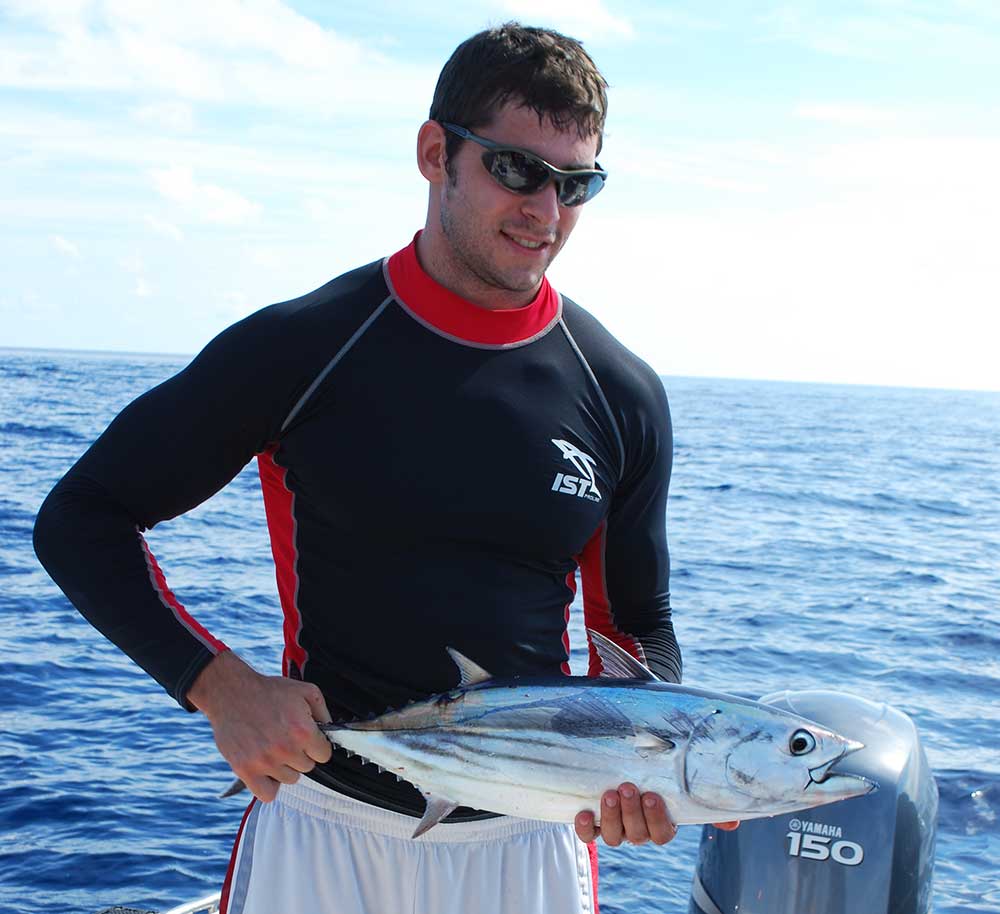
In the picture, my brother Kevin is holding a skipjack tuna. This was caught while trolling in the Florida Keys.
Trolling Lure: Little Stubby Tuna Trolling Lure
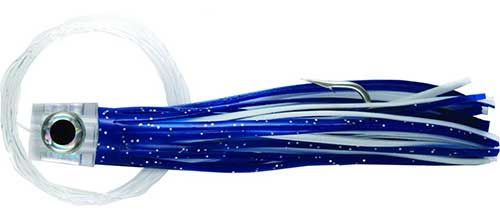
Buy from Amazon
Shop Bass Pro Shops
The C and H Little Stubby is 5-1/2 inches and weighs 2 ounces. Color options include blue-white or pink-white. The little stubby is a simple trolling skirt bait with a flat face. It is common for tuna lures to have a bullet head front. I started using these thinking they would be good for mahi-mahi and found out that they catch lots of tuna as well. These can be used with ballyhoo or strip baits but we typically just fish them without bait. This is a small and simple lure but it works.
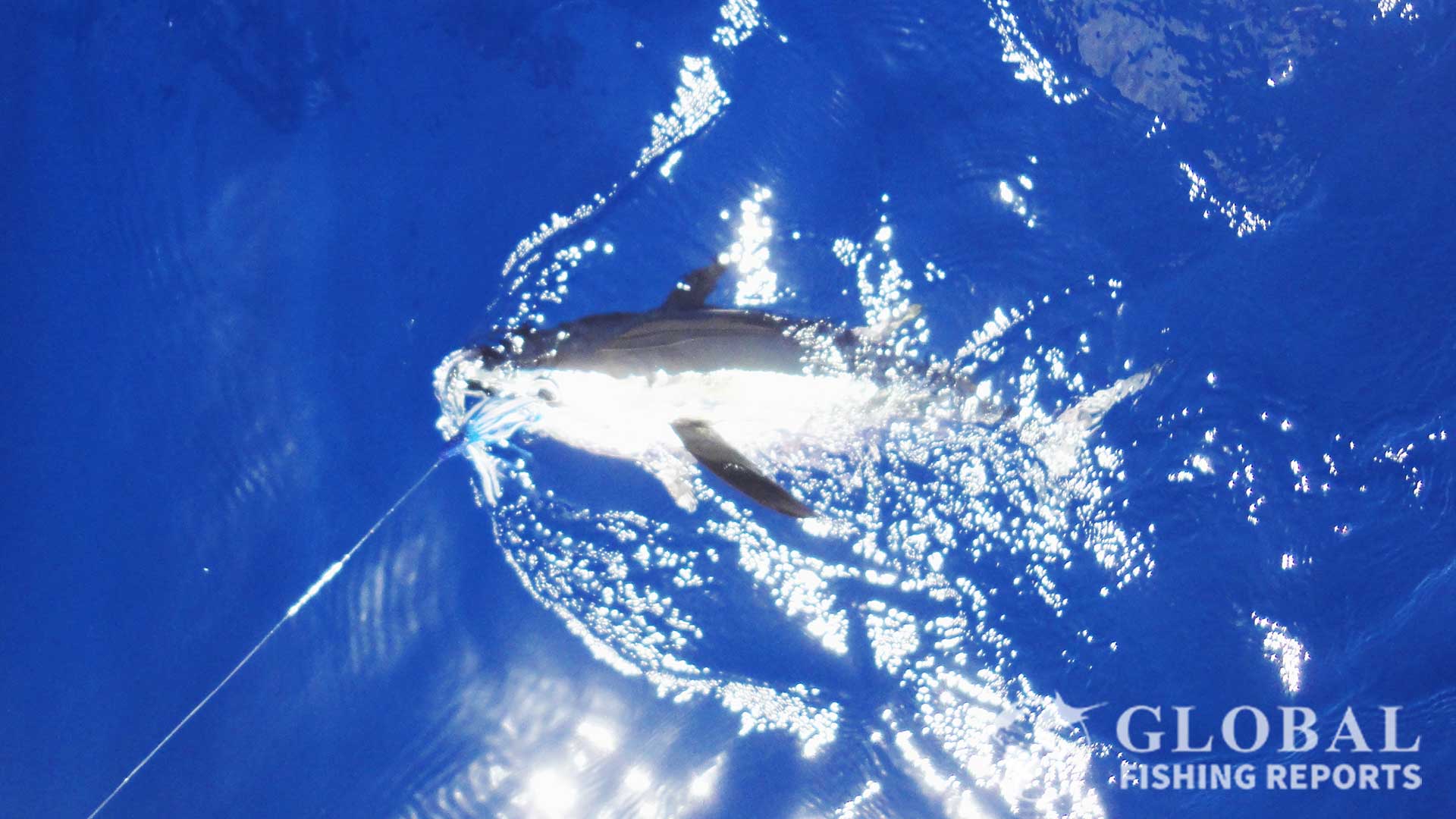
In the picture is a blackfin tuna that was caught on a blue and white daisy chain.
Trolling Lure: Green Machine Tuna Lures

Buy from Amazon
Green machine tuna lures come in 9-inch and 12-inch lengths. This set includes four green machine lures that are 12 inches long. These and rigged with a 200-pound monofilament leader line with number 8 stainless steel hooks. The heads are made with premium-grade vinyl and clear resin.
The green machine has been known as one of the best offshore fishing lures since the 1970s. It works well to catch bigeye tuna, bluefin tuna, and yellowfin tuna. The lure is not super heavy so it is typically trolled at less than 10 knots. This lure is also frequently found on spreader bars and daisy chains with a bird.
Green Machine Daisy Chain
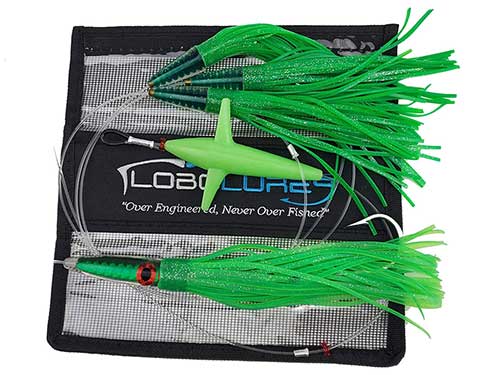
Buy from Amazon
This green machine daisy chain comes with three 8-inch double skirted green machine teasers. The main lure is a 13-inch weighted tuna bullet with a 10/0 stainless steel hook. A 5-inch glow bird is also included and the rig is made with a 10-foot 400-pound leader line.
This is a good lure to use for billfish, mahi-mahi, and tuna. These bird daisy chains are typically run mid-way back on the outriggers or way back on the shotgun. This is a well-made rig by Lobo Lures that can handle big fish. A mesh storage bag is also included with is important to keep the rig dry and organized.
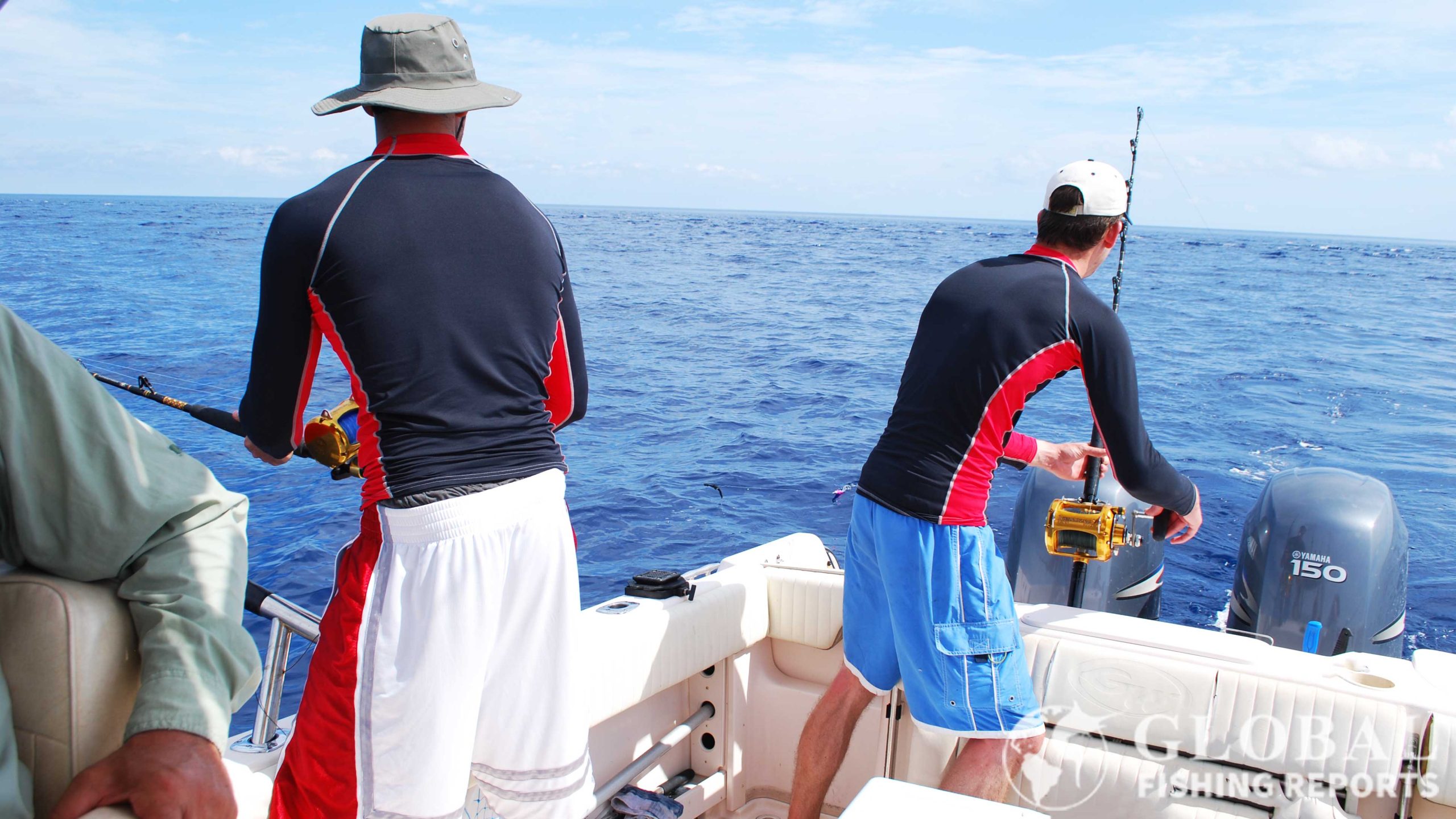
In the picture is a blackfin tuna that was caught on a blue and white daisy chain.
Trolling Lure: Tuna Feather Baits
Boone Tuna Feathers

Buy from Amazon
Boone tuna treat feathers are 6 inches in length and weigh 1-1/2 ounces. These come rigged on a 125-pound mono leader. The colors include green-yellow, blue-white, Mexican flag, red-white, purple-black, and pink-white.
Tuna feather are one of the most common lures used for tuna fishing. This tuna treat kit by Boone has 6 quaily baits with clear bullet heads with metallic reflectors. These are large profile feather baits that troll great at high speeds. The mesh bag makes this kit easy to clean and store.
Williamson Flash Feather Tuna Lure

Buy from Amazon
Shop Bass Pro Shops
The Williamson flash feathers are 4 inches long, weigh .431 ounce and come with 5/0 hooks. Color options are black-purple, blue-white, pink-white, and yellow-green. The flash feathers also come in a 5-inch size.
These trolling feathers have a smaller profile and work good to catch small to mid-size tuna. Being lightweight these only troll up to about 8 knots. If I was going to use a smaller profile bait for tuna I would stick with billy baits. That being said these are popular baits for tuna and would work great if you intend to troll below 8 knots.
MagBay Tuna Feather Daisy Chain with Bird Teaser
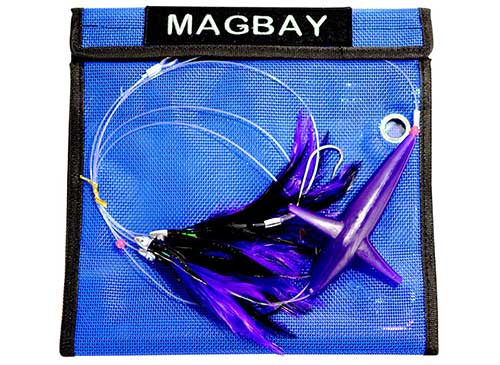
Buy from Amazon
The MagBay Daisy chain has a 6-inch bird teaser with four feather teasers. Color options include purple-black, red-white, and yellow-green. This kit also comes with a loop and hook mesh bag. The lure is rigged on a heavy monofilament leader with 7/0 hooks.
Trolling Lure: Tuna Daisy Chains
Boone Bird Tuna Daisy Chain

Buy from Amazon
The Boone bird daisy chain is a 7-inch bird teaser rigged with three Boone air eyes squid skirts and a six-inch sea minnow. The lure is rigged on a 250-pound mono leader.
Boone makes the classic quality wood birds. The same lure comes in versions with larger 9-1/2 inch and 12-inch birds. This is a great rig catch, tuna, sailfish, wahoo, and mahi-mahi. The Boone zipper mesh pocket works great to keep the lure clean and organized.
Trolling Lure: Tuna Spreader Bars

The picture above shows a Lobo Lures 5 bird spreader bar. This creates lots of surface action to get the attention of fish. It is not uncommon for people that troll for large tuna to use 2-4 spreader bars. Some days you only get one or two good chances at surface feeding tuna and getting their intention is important. These spreader bars imitate a school of baitfish or squid that are being chased by game fish. It is a beautiful thing when these lures are set-up and working in the spread.
Spreader bars can be used strictly as a teaser to bring the fish close to the other baits in the area. The spreader bars do come with a hook in the last squid bait so it does act a giant lure as well. It may seem bad to have to reel in the spreader bar and the fish. However, these are placed on a large 50 class plus reel and it is not much extra work. If the fish is pulling away it has to fight the drag of the lure as well. That being said I would not try and hook a large fish on a 5 bird spreader bar. A one bird spreader bar with some extra squids is typically no problem.
Lobo Lures Skipjack Big Game Spreader Bar
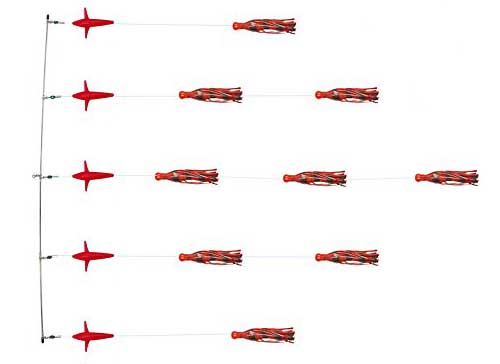
Buy from Amazon
This 36-inch spreader bar comes with 5-birds that are 5-inches or without birds. Color options include black-red, purple-pink, and fluorescent green. There are 9 skip-jack squids which are 7-inches in length. Outer lines are rigged with a 200-pound line and the mainline is rigged with a 400-pound line. The teaser bait which is the last skip-jack has a 12/0 Mustad hook. A mesh storage bag is also included. This particular lure is most popular without the birds.
The video below shows Chris from Reaper Fishing going to the Wilmington Canyon. Their boat left from Atlantic City NewJersy and made the 68-mile run. Trolling at the canyon with Sterling Tackle spreader bars the group caught lots of yellowfin tuna.
Sterling Tackle Spreader Bar Yellowfin Tuna Lure
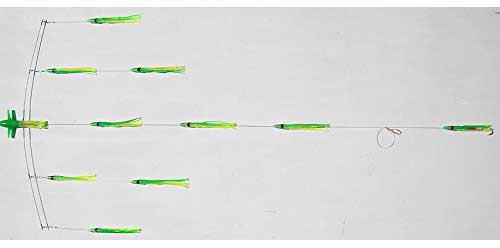
Buy from Amazon
Sterling Tackle zucchini machines spreader bar has a bid hub for straight tracking. There are 9 zucchini machine squid teasers that are 9-inches in length. A stinger bait is also included which has a 9/0 stainless steel 5-extra strong big game hook. The wing lines are made with a 130-pound line and the mainline is a 200-pound line. This spreader bar has a large profile that creates lots of commotion at the surface and can still be easily reeled in when catching large fish. A mesh lure bag is also included.
In the video below Capt. Mike from Hogy lures demonstrates how to use the Flexi spreader bar to catch bluefin tuna. He was fishing the claw 15 miles south of Martha’s Vineyard. Two bluefin tuna were caught can release.
Hogy Standard Issue Tackle Flexi Tuna Spreader Bar

Shop Bass Pro Shops
The Standard Issue Tackle spreader bar is the one shown in the video above. There are 16 UV squid teaser baits that are 6 inches in length. A replaceable 9-inch stinger bait with a 7/0 VMC tuna hook is also included. Premium 130 pound monofilament leader lines are used for the lines of the rig. The 40-inch bar is made with stainless spring steel. This is said to be more flexible than traditional titanium bars allowing the outside baits to pulse.
Hogy Bird Tuna Trolling Spreader Bar
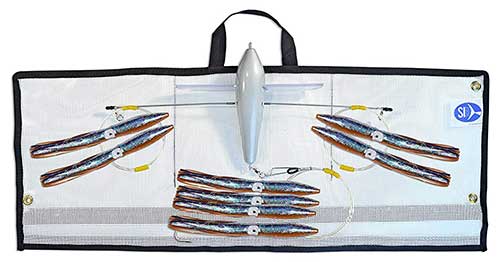
Shop Bass Pro Shops
The 18-inch splash bird has 7 machine teasers that are 9-inches in length. A stinger bait with a hook is also included. The splash bird is made out of a lightweight foam. This is a great teaser to get for people with lighter tackle. This could easily be run with a 30-class fishing reel.
Chunking for Tuna
Chunking is another effective method for catching tuna. This is done by anchoring or slowly drifting in areas where tuna concentrate. Butterfish are the most common baitfish used for chunking. The baitfish are cut into 1-inch strips and consistently tossed over the side of the boat. The idea is that if tuna come in the area and find the chunks, they will stay in the area looking for more food.
When chunking for tuna, baits are staggered at multiple depths from the bottom or 500 feet to the surface. Deep lines are set near the boat and shallower lines are put on balloons and drifted away from the boat. Typically, baits used are chunks of butterfish, sardines, live mackerel, goggle-eye, or small bluefish.
Live Bait Techniques for Tuna
Using live bait can be extremely effective for catching tuna, especially when they’re being selective. Common live baits include goggle-eyes, scaled sardines, pilchards, mackerel, herring, bluefish, blue runners, bonito, and squid. Live bait can be caught with sabiki rigs or with a cast net.
Live bait can be hooked through the nose with a small circle hook or in the back near the tail. The fish can also be bridled onto the hook somewhere between the eye and the dorsal fin.
When using live bait, fluorocarbon leaders are recommended as tuna can be leader shy. A 50-100 pound leader line is generally used that is at least 10 feet in length. When trolling, 100-200 pound leaders are a good idea, but when pitching live bait, lighter lines allow the baitfish to swim more freely and be less visible to the fish.
Live Bait: Goggle-eye, Scaled sardine, and Pilchard
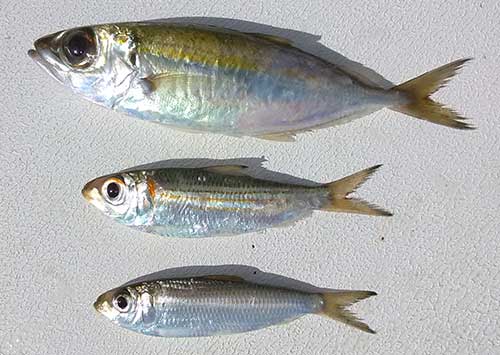
In the picture is a goggle-eye, scaled sardine, and pilchard. These all work well to catch tuna. Other common baits include mackerel, herring, bluefish, blue runners, bonito, and squid. Live bait can be caught with sabiki rigs or with a cast net. Check out our cast nets page to learn more about catching live bait.
Live bait can be hooked through the nose with a small circle hook or in the back near the tail. The fish can also be bridled onto the hook somewhere between the eye and the dorsal fin.
When chunking for tuna it is best to anchor or drift slowly. Any baitfish will work but most often flats of butterfish are used. The fish need to be thawed and cut into 1-2 inch baits on the way to the fishing grounds. Chunking is a pretty simple concept and chunks are consistently but sparingly thrown overboard. If tuna swim by the chunk can help keep them in the area looking for more food. Several baits are set from the bottom to the surface. Chunking sessions typically last for 4-8 hours.
Tuna Circle Hooks
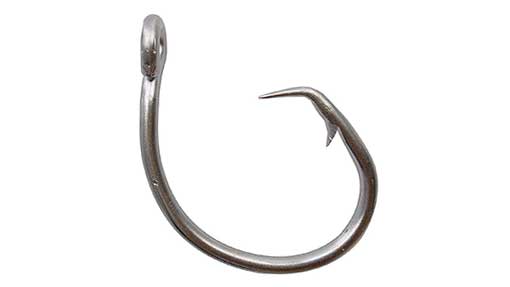
Buy from Amazon
Shop Bass Pro Shops
A circle hook is a good idea when fishing for tuna. The hook size will vary based on the bait being used. When fishing for an average 10-50 pound tuna an 8/0 circle hook is a good size. I use the size 16/0 when fishing for large sharks and halibut. When fishing with small live bait like pilchards a thinner hook would typically be used.
Tuna Sinker Weights
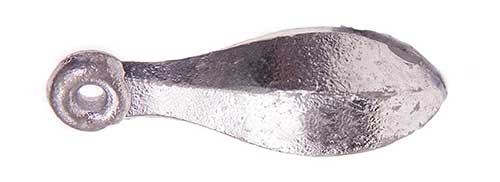
Buy from Amazon
Shop Bass Pro Shops
These lead bullet weights come in sizes from 1 ounce to 20 ounces. The number of weights that come in each pack varies based on the size.
There are the perfect weights to use to sink tuna baits deep. A rubber band is placed through the hole of the weight and then through the hole in the rubber band. The band is attached to the fishing line by wrapping the rubber band around the line and them placing the weight trough the hole of the rubber band.
When sending tuba baits deep first let out about 50 feet of line. Next, attach the weight to the line with the rubber band. Weights from 6-ounce to 16-ounces are used to stagger baits at different depths. Deep lines are set near the boat and shallower lines can be set with balloon floats away from the boat. If chunking, it is important to also flatline a bait that sinks naturally with the chum with no added weight.
Tuna can be leader shy so a fluorocarbon leader line should be used. A 50-100 pound leader line is generally used that is at least 10 feet in length. When trolling 100-200 leaders is a good idea but when pitching live bait light lines allows for the baitfish to swim more freely and be less visible to the fish.

In the picture, my sister Amy has skipjack tuna that caught with a purple-blue and silver Billy Bait. The tuna was bitten in half by a shark while reeling it in. Also, note that she is wearing a personal locator beacon on the life jacket. If you are fishing by yourself, it is a good idea to always be wearing a rescue beacon. It is also smart to have a PLB or EPIRB on the boat anytime going offshore.
Dead Bait: Fresh Squid
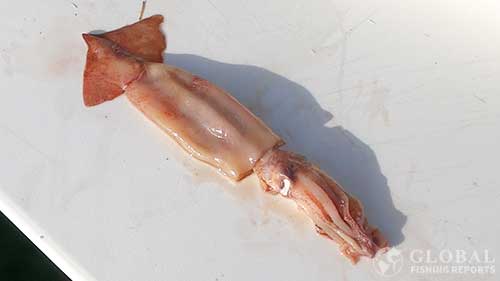
When drifting this lure adding fresh squid is a good idea. Squid is also a good tuna bait in general. When fishing at night tuna has a strong scent to attract fish and encourage them to bite.
Most of the time when fishing at night large spreader bar lights are shined into the water. This attracts plankton and baitfish which then attracts the larger predator fish like tuna.
Vertical Jigging for Tuna
Vertical jigging is highly effective for catching tuna, especially when they’re holding deeper in the water column. Tuna are frequently found at depths from 500 feet to the surface. By dropping 3-12 ounce jigs for about two minutes, you can cover all the water depths. If the jig stops on the way down, that means a fish has bitten the lure.
When fish don’t bite on the way down, they can bite during the lure retrieval. When bringing the lure up, raise the tip of the rod quickly, then reel down and repeat. This makes the lure travel fast and then pause briefly, triggering reaction strikes.
Jigging can be a great way to catch fish on high-traffic days at the humps when heavy trolling pressure has pushed the tuna deeper. Sometimes the bigger fish are at deeper depths, so it’s worth jigging to see what’s deeper in the water column.
Tuna Jigs: Shimano Butterfly Flat-Fall
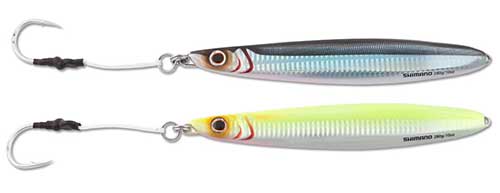
Buy from Amazon
Shimano jigs come in sizes ranging from 2-3/4 ounces to 11.5 ounces. Color options include black anchovy, black-silver, blue sardine, brown-silver, chartreuse-silver, green-silver, orang-gold, phantom squid, pink-blue, pink-silver, purple-silver, sand eel, super glow, zebra glow, and white-silver.
Butterfly jigs work well when fishing for deep tuna on the humps or canyons. Humps are underground mountains that for example go from 1000 feet up to 500 feet and then back to 1000 feet. Jigs also work well when fishing structure and wrecks. The Gulf Stream flows across the underwater mountain or ledges which creates upwelling currents that bring nutrient-rich plankton and baitfish to the surface. The water turbulence makes bait vulnerable to predator fish like tuna, mahi-mahi, amberjack, sailfish, and marlin. Sharks are frequently lurking in these areas which can make landing hard fighting fish difficult.
The humps in the Florida Keys include the Key Largo Hump, Islamorada Hump, 409 Hump, Marathon Hump, and the Carlson’s Two Humps. There are many canyons stretched along the entire east coast of the United States. Canyons are 55-75 miles offshore so traveling to these locations takes time and requires decent weather conditions. The canyons are where the ocean floor quickly drops from around 500 feet to over 1500 feet in a short distance. This is where the tuna and other pelagic fish are often concentrated.
When deep dropping vertical jigs for tuna a 4.5-ounce lure is considered light and an 8-ounce lure is considered heavy. These jigs are used with heavy-duty spinning reels or conventional jigging reels. Initially, the bail on the reel is open and the lure falls freely. If the jig stops that means a fish is on the line so real any slack up as quickly as possible and fight the fish. After a 60 second count, the 4.5-ounce jig will be at about 100 feet and the 8-ounce jig will be at about 200 feet.
There is a typically strong current and wind moving the boat so engine power is often needed to slow the drift. After the jig reaches the desired depth pump the rod with fast pulls upward followed by dropping the rod tip and reeling. During the reel down the lure will pause briefly which gives the fish time to strike. This can be a great way to catch fish on high traffic days at the humps when heavy trolling pressure has pushed the tuna deeper. Sometimes the bigger fish are at deeper depths so it is worth jigging to see what is deeper in the water column.
Owner assist hooks are good to use with these jigs. Also, wire assist hooks are good when wahoo might be in the area. There should be two assist hooks added to each jig’s split ring. The fishing line is tied to the split ring between the two hooks. A hook could be added to the rear of the jig but this is not typically done.
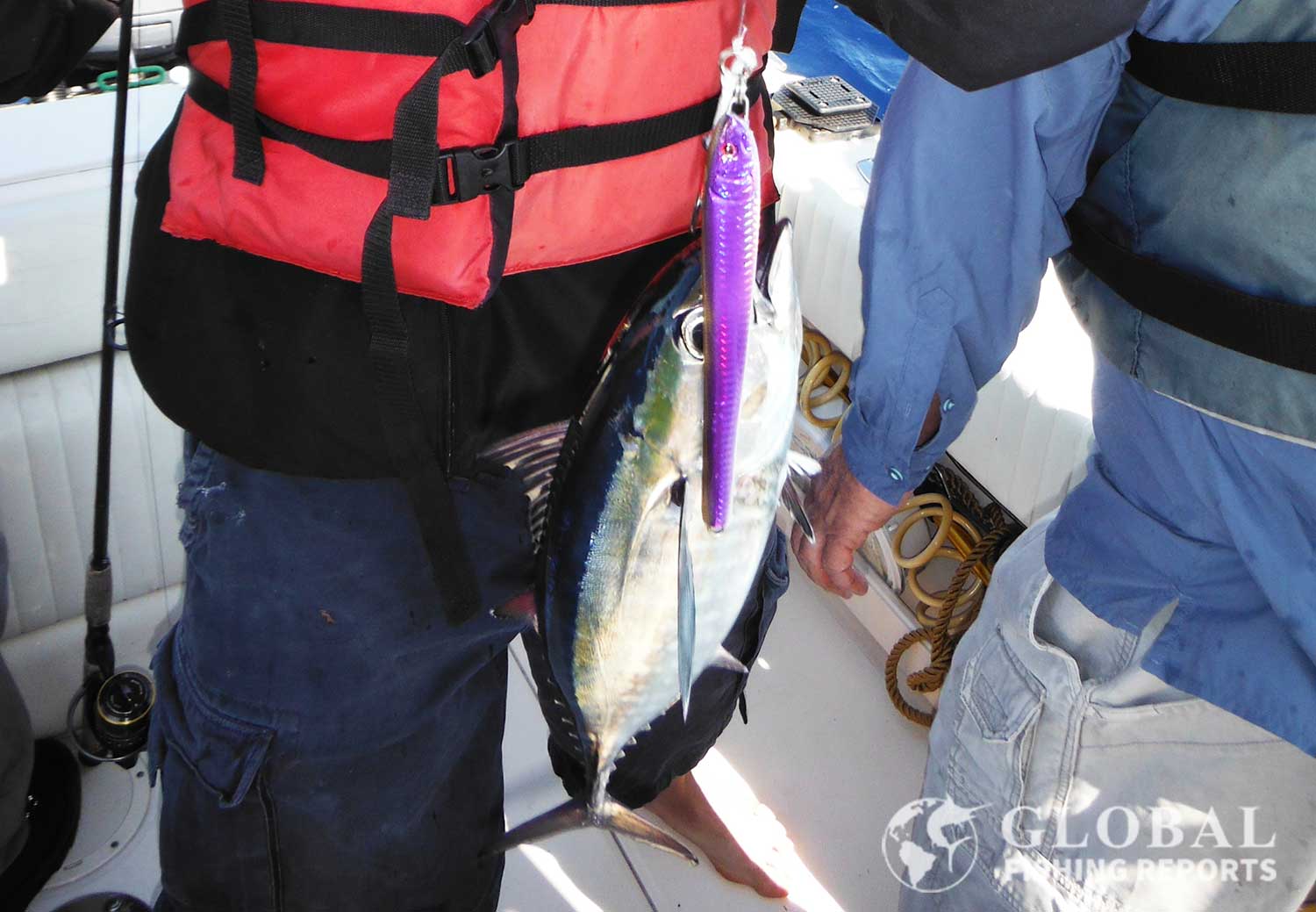
The Shimano jig above is a 200-gram jig. This large jig even works for catching small tuna. The two assist hooks are in the front of the jig and fish will typically bite the jig head first. This is why the hooks are tied to the front of the jig.
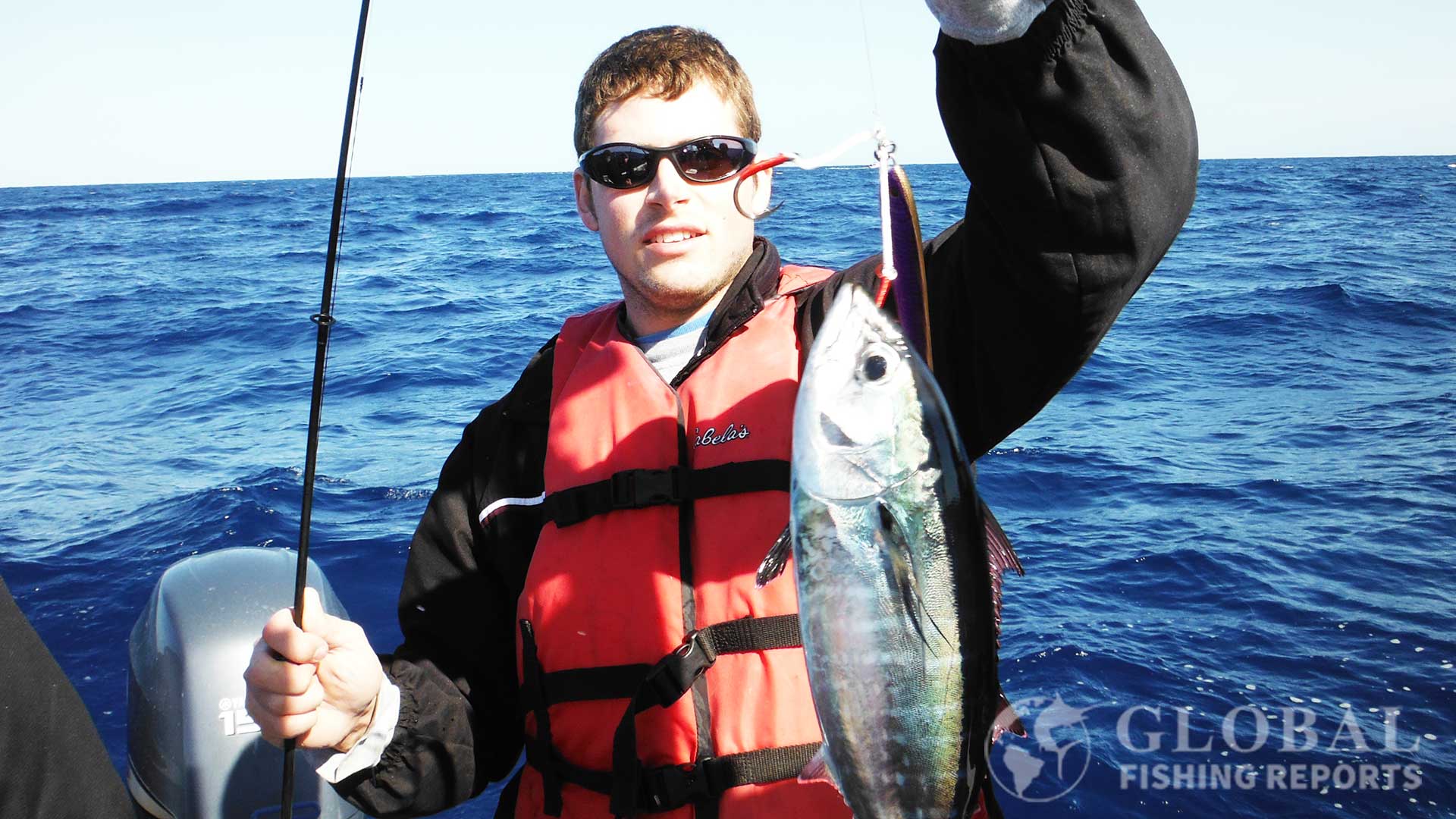
The assist hooks are tied on with a thick braided line. Several times we have we have had these jigs cut from fish with teeth. Wires assist hooks could be used if there are wahoo or sharks in the area.
Tuna Jigs: Fast Fall Butterfly Tuna Jigs

Buy from Amazon
Shop Bass Pro Shops
Calissa fast fall jigs come in sizes of 80 grams(2-3/4 ounces), 150 grams(5.29 ounces), and 250 grams(8.75 ounces). Color from top to bottom are blue mackerel, white squid, red crab, pink smelt, glow in the dark, and green sardine. The jigs are painted with 7 layers of gorilla paint and have a sealed finish to prevent flaking and chipping. Two 3/0 heat-forged carbon steel hooks on assist cords are included with each jig. Bass Pro Shops Offshore Angler series has a very similar style fast fall vertical jig.
These come as individual jigs or as a package. Blue mackerel and glow-in-the-dark are both good colors for tuna. The 80-gram jig has a body length of 3-5/8 inches, the 150-gram jigs have a body length of 4-4/2 inches. Shimano has options for longer or shorter jigs. The benefit of these jigs is they are very similar and are typically a lower cost.

In the picture, my brother Mark is fighting a fish that was caught on a butterfly jig. While reeling the fish up it got eaten by another fish that cut off one of the assist hooks. This was very likely from a shark. Note the short fishing rod and large spinning reel that is used for vertical jigging. A stiff rod and 80-100 pound braided line is typically used.
Tuna Jigs: Sand Eel Tuna Jigs
Canal Sandeel Green Mackerel Tuna Jig
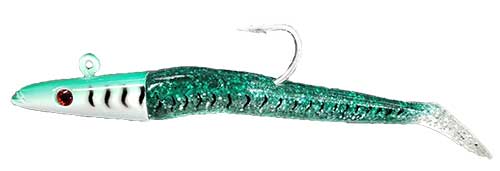
Buy from Amazon
This Canal Sandeel has a green mackerel color pattern. The jig weighs 5.25 ounces and is 8-inches in length. Included is the painted lead jig head and three soft plastic swim tails. Spring action holders keep the rubber body on the jig without superglue. The 9/0 Mustad hooks on this jig are stronger than hooks that come on smaller swim jigs. That being said don’t use super high drag or the hook can bend.
Ronz Lures Tuna Jig

Buy from Amazon
Shop Bass Pro Shops
This Ronz green glow jig weighs 4-ounces and is 10 inches in length. Other tail color options include olive metallic, silver metallic, white pearl, pink fluorescent, and black pearl. A power swivel and eyes built into the lead jig head.
This is a medium heavy duty class jig with ultra-sharp 11/0 owner 3 extra strong hooks. The jig is recommended for tuna and other fish up to 125 pounds. Ronz also makes heavy-duty class jig with a smaller 4 extra strong hook. These bodies are similar to slug-go baits which are popular striped bass lures and Hogy swim-baits which are popular tarpon lures. This is a good bait because it can be easily jigged to about 200 feet. The jig can also be trolled and will stay beneath the surface where it will be more visible than surface baits.
Goture Sand Eel Jigs

Buy from Amazon
The Goture jigs are 4-inches in length and weigh .77 ounces. Color options include black-silver glitter, red-white, gold-glitter, double glow, and blue-silver glitter. Size 2/0 black nickel hooks are uses. PVC bodies have a swim tail and the head has built-in 3D eyes.
These lightweight jigs work well at catching fish in the top 100 feet of water. They are not a heavy-duty but can be used to catch smaller blackfin tuna, skipjack, and bonito.
Other Trolling Options
Trolling Lure: Naked Ballyhoo
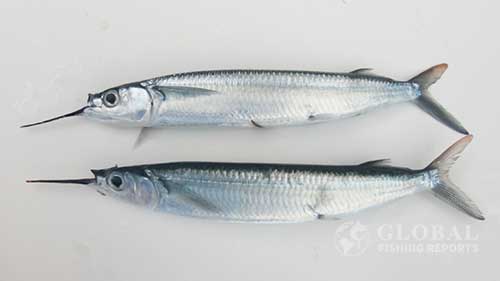
Trolling ballyhoo is a good way to catch tuna. Artificial baits are so good that some charter operations no longer use ballyhoo. However, most charter operations still run one or two lines with naked or skirted ballyhoo.
Ballyhoo baits give a natural appearance and add scent to the lures. The disadvantage of using ballyhoo is the troll speeds should not exceed 8 knots. This makes it difficult to speed up to chase bird and fish activity.
Also, the bellies of the ballyhoo can become soft and get washed out. When this happens the lure looks terrible and will not catch fish. That being said if you are coming up on fish activity getting fresh ballyhoo baits in the trolling spread is a good idea.
Rigging Wire for Ballyhoo Rigs

Buy from Amazon
Shop Bass Pro Shops
This is 14-inch copper rigging wires. It comes with 50 copper wire strands in a clear plastic tube with red caps. Rigging wire is the most common way to secure ballyhoo to the hook. The wire is wrapped around the eye of the hook and then around the front of the ballyhoo. There are many YouTube videos on how to rig a ballyhoo.
An easier way to rig ballyhoo is with ballyhoo bait springs. The hook is placed through a gill and out the bottom of the bait like normal. Rather than using wire, the bait spring is rotated onto the front of the ballyhoo after the beak is broken off.
Mustad 2-Extra Strong Tuna Fishing Hook
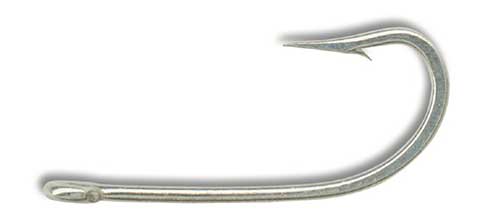
Buy from Amazon
Shop Bass Pro Shops
Mustad 2407 size 8/0 hooks are the standard hook used to rig ballyhoo. I like using the 2 extra strong versions of the hook. Over 30 pounds of drag on the standard hook can cause it to straighten. Even the 2 extra-strong versions can straighten so only use high drag in desperate situations.
The video below shows a video by National Geographic of bluefin tuna feeding on a bait ball.
Trolling Lure: Ilander-Jr

Buy from Amazon
Shop Bass Pro Shops
The Iland Ilander Jr is 6-3/4 inches in length, weighs 1-3/4 ounces and has a bullet head. Color options include blue-white, pink-white, blue-chartreuse, and black-purple. This bait has a nylon skirt with strands of mylar prism.
Bullet-head lures are the most common to use for tuna fishing. Ilander lures are great baits to run with or without ballyhoo. The original Islander is 8-1/4 inches and weighs 4 ounces. That is also a good bait to use for tuna. I like having a mix of small and large profile baits in the trolling spread.
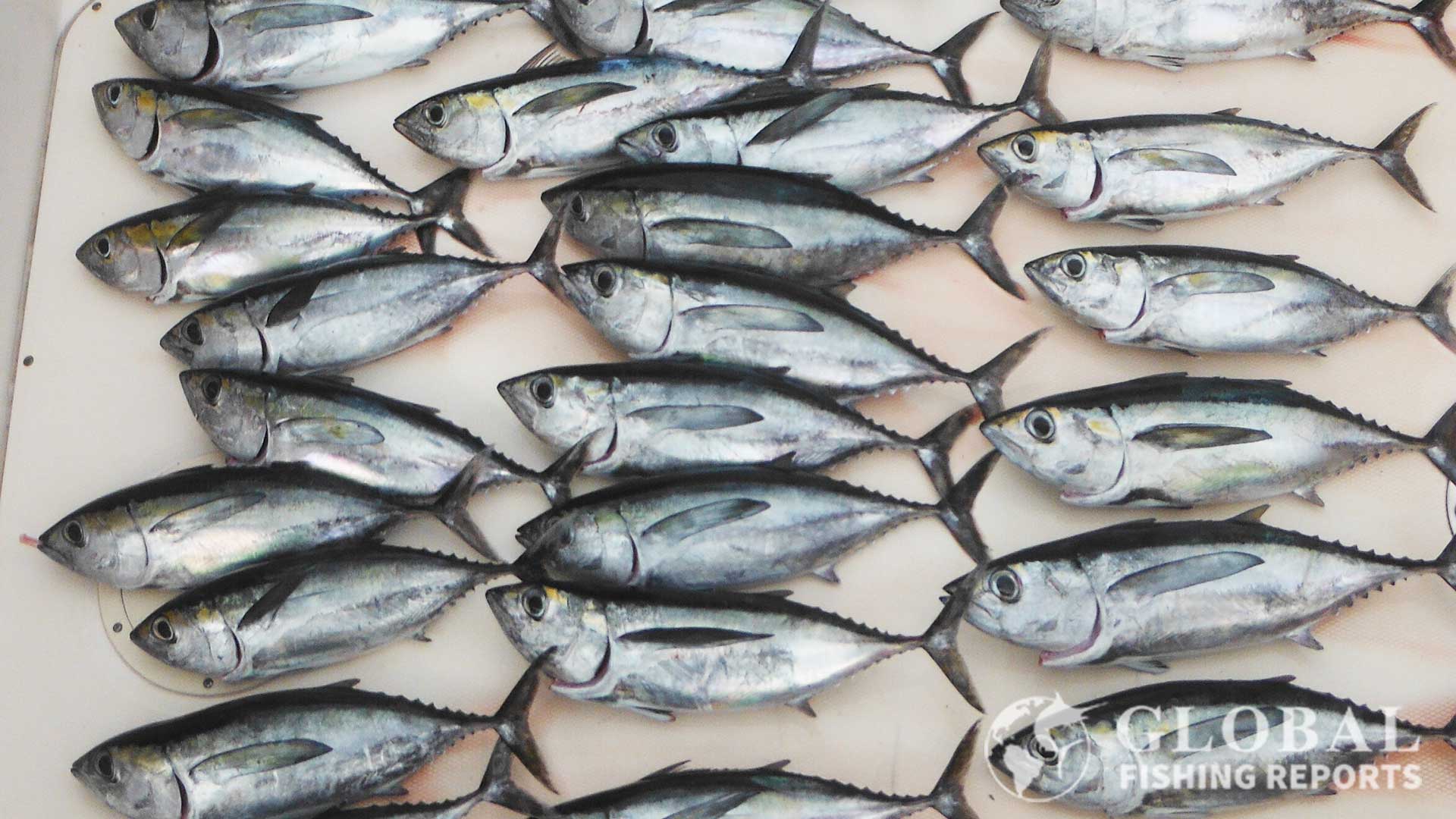
In the picture above are blackfin tuna that were caught in the Florida keys. Blackfin tuna is my favorite fish to each when it is fresh! However, it does not freeze particularly well so it is not recommended to keep a large number of blackfin tuna. The daily limit use to be 100 pounds of tuna per vessel in state water and no limit in federal waters. On most trips, after catching 5-10 blackfin tuna for the boat we would target other fish and let blackfin tuna go if we catch them. It was encouraged that others did the same but many people did not.
Concerns of declining catch rates in typically high catch areas led to limits being put into place. The new tuna regulations limit catch rates of two blackfin tuna per person per day or 10 fish per vessel, whichever is greater. The new law applies in both state and federal water. There is still no size limit. I personally like the new law as ten blackfin tuna is plenty of fish to eat for a week.
Trolling Lure: Glog in the Dark Squid
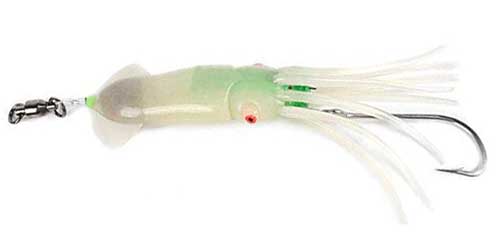
Buy from Amazon
Shop Bass Pro Shops
Dr. Fish Trolling Squid has a built-in LED light that lasts 300 hours. The lure is 6-inches in length and weighs 2.47 ounces. Two lures come per pack with color options of white, blue, red and green. The led light is water activated and the skin also glows in the dark. Bulbs in the head and skirt provide a dim light and flash like a strobe light.
A lead egg sinker is in the front of the squid bait. Braided steel wire is used to connect the 6/0 hook to the bait. The line connection is a 150-pound test ball bearing swivel. Most people know that swordfish are attracted to lights. Tuna can also be caught with lights at night but they are not required. This lure can be trolled in low light conditions or dropped deep with extra weight when drifting or on anchor. Bass Pro Shops offers a B2 squid that is heavier but does not have an LED light.
Trolling Lure: The Big Game Catcher

Buy from Amazon
Shop Bass Pro Shops
The Williamson big game catcher is an 8-inch lure and weighs 2-1/2 ounces. This lure comes pre-rigged on a 5-foot 175-pound test suffix leader line with a 9/0 VMC hook. Color options include blue-pink-silver, black-purple, bleeding dorado, bonito, Lumo, pink-white, red-black and Halloween.
Custom 8 Inch Tuna Lure
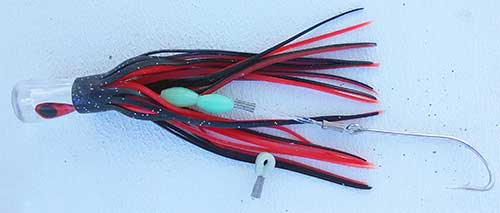
The pictures above show a custom rigged 8-inch lure similar to the big game catcher. The lure has two large beads to space the hook just past the skit. This helps reduce the number of short strikes. This particular lure caught a small tuna which got eaten by blue marlin. It did not get hooked though. Luckily it can back and took a blue and white stubbly bubbler and we were able to catch the marlin.
Trolling Lure: 9-inch Classic Offshore Trolling Lure
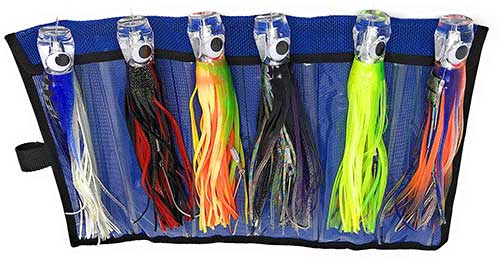
Buy from Amazon
Shop Bass Pro Shops
These big game trolling lures are 9 inches in length and weigh 3.8 ounces. Colors include blue-white, black-red, bleeding dorado, purple-black, yellow-green, and purple-orange. The lures come rigged on a 6-foot 130-pound leader with 9/0 big game hooks. These lures come ready to catch big fish with no rigging required. Six lures come in the set and a mesh bag is included to keep the lures organized and dry. Bass Pro offers the Williamson Big Game Catcher kit which is similar but rigger with 175-pound mono leader line.
Trolling Lure: Cedar Plug
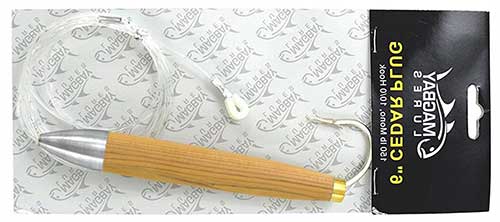
Buy from Amazon
The MagBay cedar plug is 6 inches in length and weighs about 2.5 ounces. This lure comes rigged on a 150-pound mono leader. The color is all-natural wood with a silver head. Three of the same plugs come in this set.
Cedar plug lures are a classic trolling plug to catch all types of tuna. The natural plug is actually a great color. Ther are companies that sell different color cedar plugs but are of lower quality than this MagBay lure. It could be a fun project to paint the lures with your own designs.
Deep Trolling Lure: Sea Witch on a Planer
Sea Witch 1.5-ounce Tuna Lure
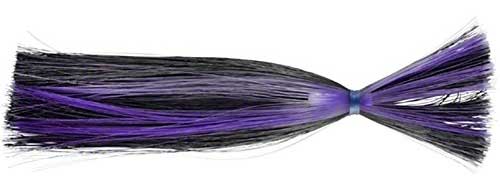
Buy from Amazon
Shop Bass Pro Shops
The sea witch comes in weights of 1/8 ounce, 1/4 ounce, 1/2 ounce, 3/4 ounce, 1 ounce, 1.5 ounces, 2.5 ounces, and 4 ounces. Color options include pink-white, blue-white, and black-purple. These lures are usually run with ballyhoo on a planer or downrigger. These also frequently catch mahi-mahi and wahoo. When targeting tuna a clear leader material must be used. Using a 200-pound or greater fluorocarbon leader is a good idea to still have a chance a wahoo.
Sea Strike Size-4 Planer
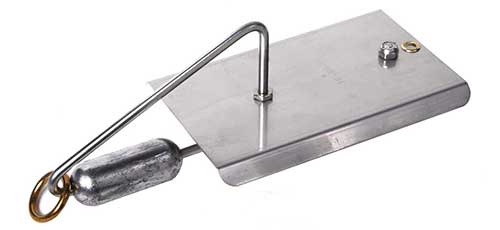
Buy from Amazon
Shop Bass Pro Shops
The Sea Strike planer comes in size 1 which runs 5-12 feet deep, size 2 which runs 10-20 feet deep, size 3 which runs 12-25 feet deep and size 4 which runs 15-30 feet deep. The size corresponds to the weight of the lead on the front of the planer in ounces. There is also a size 8 high-speed planer that gets tied off to the boat and acts similar to a downrigger.
I would recommend getting a size 3 or size 4 planer when using large baits. A snap swivel from the pole connects to the front metal ring. A snap swivel with a 30-50 foot leader then connects to the back of the planer. For tuna bullet head skirted baits and sea witches are the best lures to use.
When the planer is placed in the water the metal ring slides toward the back and sets the planner pulling down. When a fish strikes the ring slide forward stopping the planer from diving. If the planer pole releases without catching a fish, raise the rod and drop it quickly to put slack in the line. This should reset the planer to dive. When a fish bites the line tension may decrease so be ready to reel in the slack like when using downriggers.
Tuna are very often deep in the water column so having at least one bait deep when trolling is a good idea. Planners are one way to achieve this. Leadering the fish with an inline planer can be tricky because of the length of the leader. A simpler way to get a lure below the surface is with a deep-diving plug like a Rapala X-Rap or Nomad DTX minnow.
Deep Trolling Lure: Nomad DTX Minnow Tuna Lure

Buy from Amazon
Shop Bass Pro Shops
Nomad DTM Minnows come in sizes from 3.3-inches to 9-inches. All of these lures can work for tuna but the 6.5-inch and larger sizes swim deep in the water which is the goal of running diving plugs. Size 165 is a 6.5-inch lure that weighs 3.75 ounces and dives 34 feet. The next size up is the 200 which is an 8-inch lure that weighs 5.5 ounces and dives 40 feet. Finally, the largest Nomad is size 220 which is a 9-inch lure that can dive 50 feet.
The Nomad Lures are becoming one of the most popular offshore fishing plugs. These baits gained a reputation for being good baits for wahoo being trolled at speeds up to 12-14 knots. This lure is built strong with a metal matrix plate system and diamond armor. An autotune system and hydrospeed belly eyelet technology allow the lure to run straight at high speeds.
For tuna fishing, a 150-200lb monofilament or fluorocarbon leader should be used with small crimps. Using braided line for the mainline allows these lures to run deeper in the water. The large single inline hooks are great for catching large fish.
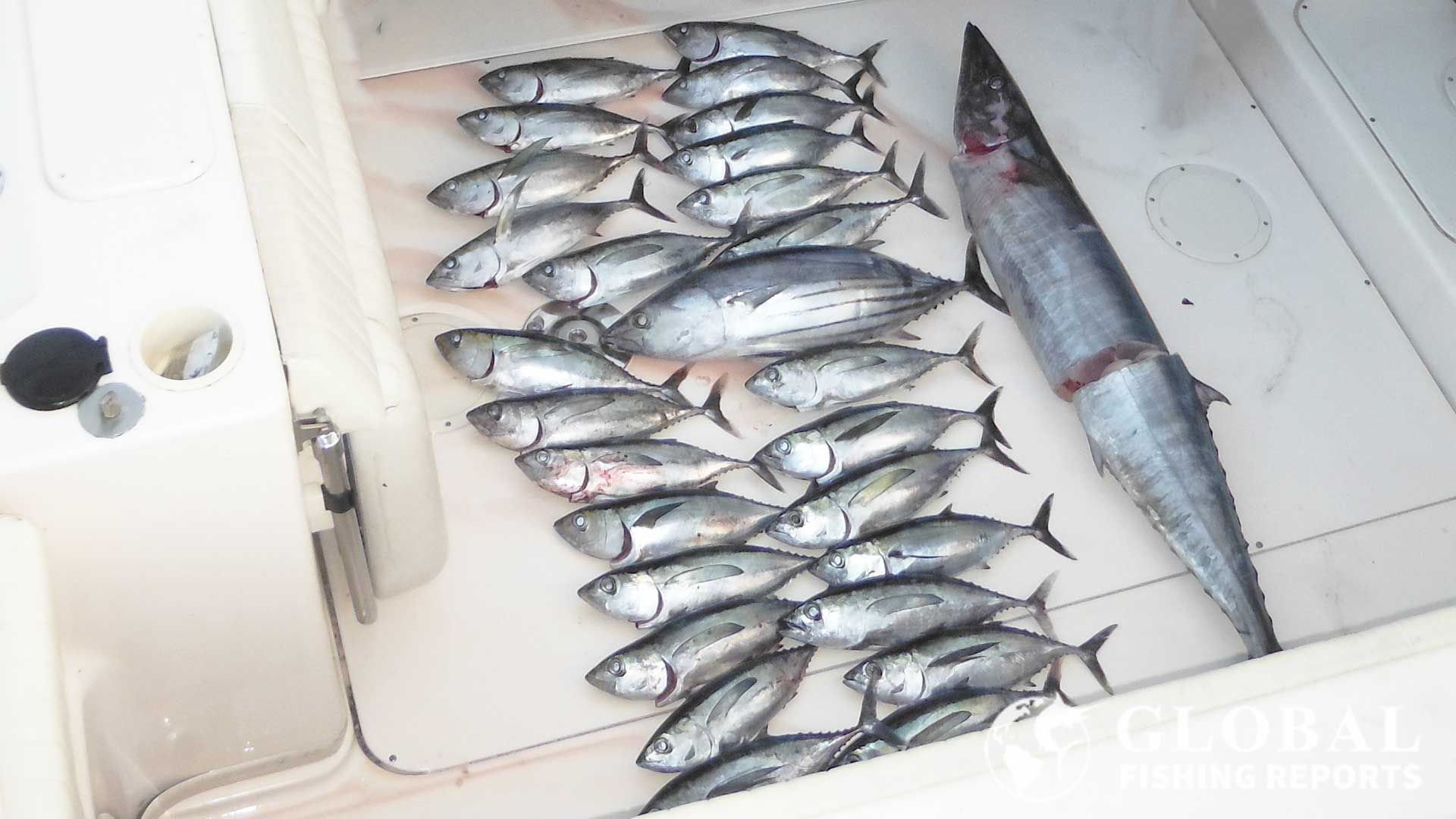
In the picture above are blackfin tuna, skipjack tuna, and a wahoo. These were caught while trolling in the Florida Keys.
Casting for Tuna
The key with popper fishing for tuna is to keep the lure moving. Unlike with some other species, a steady retrieve with occasional pops works best for tuna as they are naturally attracted to fast-moving prey. While this method may not catch the most tuna, it is definitely a fun way to hook up.
Casting Surface Popper: Yo-Zuri Bull Pop
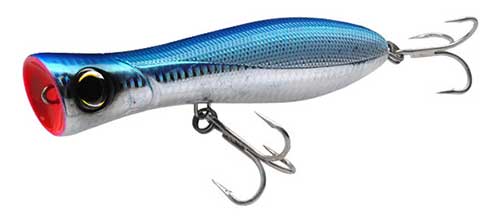
Buy from Amazon
Shop Bass Pro Shops
The Yo-Zuri Bull Popper comes in sizes 6-inch, 2-1/2 ounces and 8-inch, 5 ounces. Color options include pearl pink-yellow, ballyhoo, chrome sardine, dorado, holographic blue, mackerel, and red-head. Oversized poppers also work well to catch large mahi-mahi
Commercial fishermen can catch boatloads of tuna with cane poles. So you would think surface popper could catch lots of tuna as well. In my experience surface, poppers are not going to catch the most tuna but are the most fun way to catch tuna. This lure is used in up close and personal encounters with tuna blitzing and breaking the surface. If they are large yellowfin tuna or bluefin tuna it is definitely an adrenaline-pumping experience of a lifetime. I once cast a Popper to a huge school of bluefin Tuna that were blitzing in Cape Code Massachusetts and still remember the feeling. There should always be a large surface popper on the boat ready for these special occasions. Remember that tuna like a chase so pop the plug and keep it moving.
Tuna Fishing Tackle and Gear
When targeting tuna, having the right equipment is crucial. For trolling, conventional reels in the 30-50 class range with 50-80 pound test line are standard. For jigging, heavy-duty spinning reels or conventional jigging reels with 80-100 pound braided line and stiff rods are ideal.
Circle hooks are recommended when fishing for tuna, especially when using live bait. The hook size will vary based on the bait being used. When fishing for an average 10-50 pound tuna, an 8/0 circle hook is a good size.
For sending baits deep, bullet weights from 6-16 ounces can be used to stagger baits at different depths. Deep lines are set near the boat and shallower lines can be set with balloon floats away from the boat.
Tuna Species and Eating Quality
Different tuna species offer varying eating qualities:
- Bluefin Tuna: Highest value for sushi and sashimi purposes. Conservation status is concerning with populations declining significantly in recent decades.
- Yellowfin Tuna: Excellent for tuna steaks that are seared or cooked through. Also sashimi-grade.
- Blackfin Tuna: Underrated for eating quality. Fresh blackfin tuna is my favorite fish to eat. It’s sashimi-grade when fresh but doesn’t freeze well.
- Skipjack and Albacore: Typically used for canned tuna, though they can still make good eating when fresh.
- Bonito/Little Tunny: Generally considered the least desirable tuna for eating, though if the fish is small and the dark bloodlines are removed, it can be quite good.
Conservation and Regulations
Blufin Tuna
Tuna conservation is crucial for maintaining healthy populations. Bluefin tuna in particular have population concerns, with Atlantic bluefin tuna populations declining by 72 percent in the eastern Atlantic and 82 percent in the western Atlantic over the last 40 years.
For bluefin tuna, there is a set number that are allowed to be caught each year at different sizes. All catches must be reported within 24 hours. As bluefin tuna take 8-12 years to reach sexual maturity, keeping the large breeding fish in the ocean seems like the best way to increase the population.
Blackfin Tuna in Flordia
In Florida, new tuna regulations limit catch rates of blackfin tuna to two per person per day or 10 fish per vessel, whichever is greater. The new law applies in both state and federal waters. This is a significant change from previous regulations when the daily limit was 100 pounds of tuna per vessel in state waters with no limit in federal waters. I personally like the new law as ten blackfin tuna is plenty of fish to eat for a week.
Captain Cody has worked on charter fishing boats in the Florida Keys, Virgin Islands, and Alaska. Growing up in Pennsylvania Cody has also done extensive freshwater fishing including bass fishing tournaments. Cody strives to provide detailed information about the best fishing gear and tactics to help both novice and experienced anglers have a more productive and enjoyable time on the water. Cody also has a background in aerospace engineering and neuroscience but really only takes pride in being good at one thing and that is fishing!
How to Catch Wahoo: High Speed Trolling, Trolling, and Jigging
Wahoo are one of the most exciting fish to catch. During the first run after a bite, wahoo peels line off the reel as if it were a giant shark. Wahoo are found in warm water from New Jersey to the Caribbean in water as shallow as 50 feet deep. They are generally scattered about and not in large schools. These fish are often found in the same waters as tuna, mahi-mahi, and sailfish and bite on similar baits. This can be problematic because wahoo have sharp teeth and typically require a steel leader to be caught. They primarily eat fish and squid.
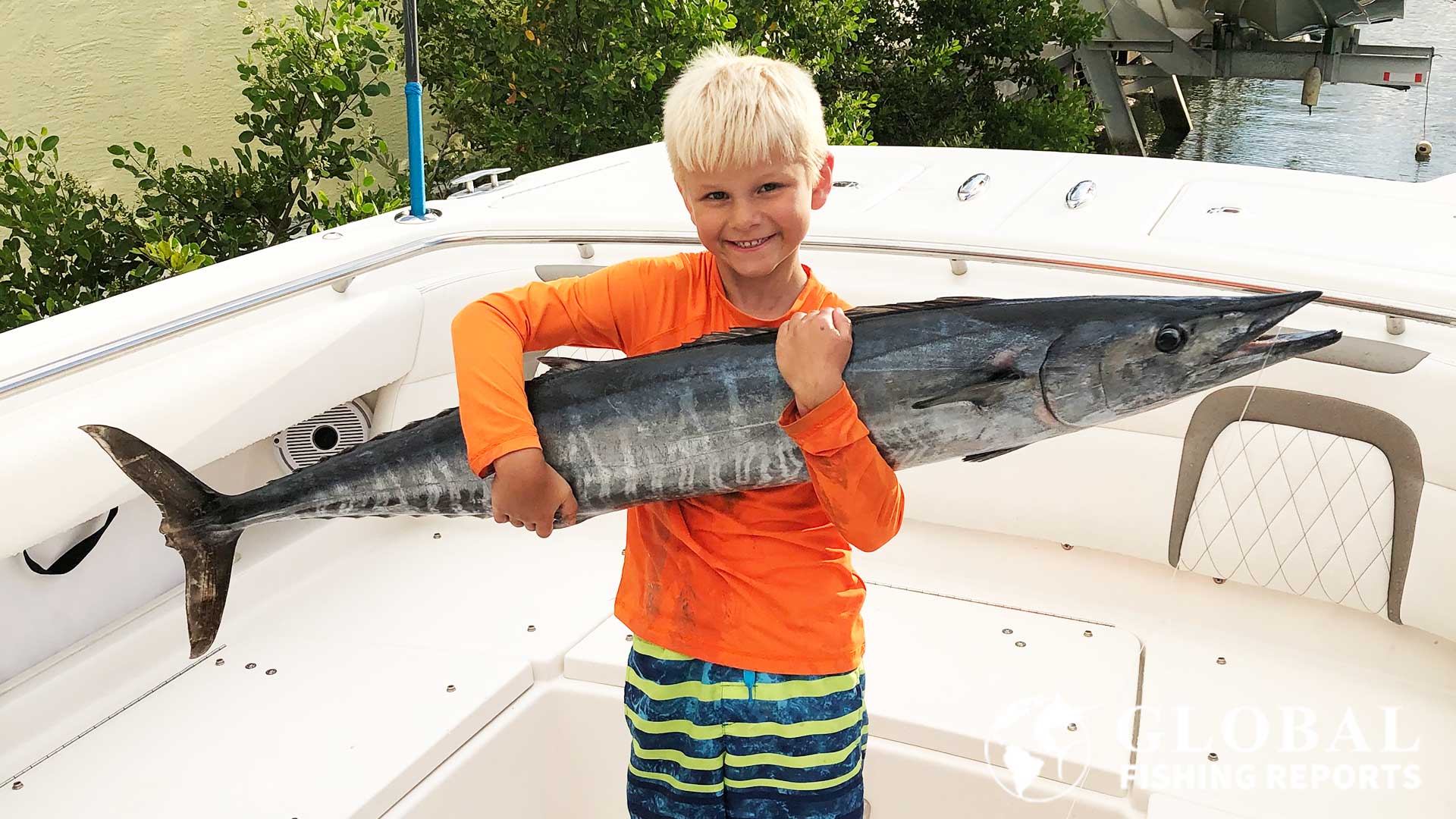
Wahoo Fishing Methods
Wahoo can be caught with trolling skirts, deep diving plugs, vertical jigs, and high-speed trolling lures. To get an idea of what anglers thought was the best wahoo lure a poll was started on the Facebook group Wahoo Junkies. The results are shown above and the details of the lures are provided below ranked in order of popularity based on the poll. The two main styles of wahoo fishing are high-speed trolling and regular-speed trolling. Depending on which method is being used will determine which lures and baits will be used.
Wahoo Junkies Poll Results, 152 Total Votes
| Votes |
Best Wahoo Lure |
| 70 |
Bullet Head Ilander Style Skirt |
| 31 |
Nomad DTX Minnow, Diving Plug |
| 17 |
Yo-Zuri Bonita |
| 6 |
Sea Witch with Ballyhoo on Planer |
| 6 |
Billy Baits Mr. Big, High Speed Jet Skirt |
| 4 |
Black Bart, High Speed Skirt |
| 4 |
Cowbell Style Lures |
| 2 |
MOAB Mother Of All Baits |
| 2 |
Chin Weighted Mullet |
| 2 |
Rapala Magnum, Diving Plug |
Trolling Lure: Bullet Head Ilander Style Skirt
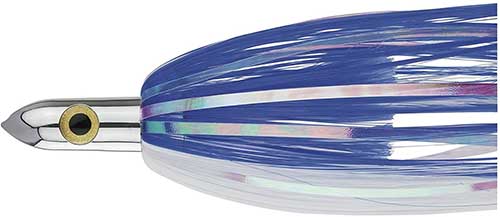
Buy from Amazon
Shop Bass Pro Shops
The Iland Ilander is an 8.25-inch lure that weighs 4-ounces. Color options are blue-white, black-purple, and blue-pink. This is the flash version with a mylar and hair skirt.This was rated the number one style wahoo lure which is likely because this is a versatile lure. It can be rigged with ballyhoo and run a planer or downrigger. I have had the best luck using this lure on a planner rigged with a ballyhoo trolling around 8 miles per hour.
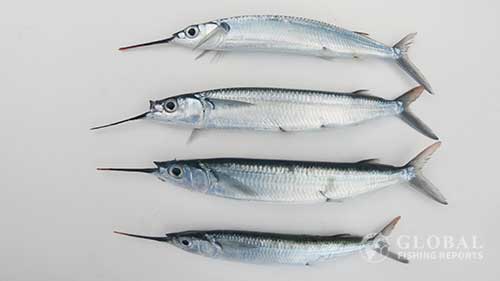
Ballyhoo can be added using rigging wire and multi-strand cable or with single strand wire and ballyhoo springs. This lure can also be run at high speeds with an inline trolling weight rather than a planer. At high speeds, the Ilander is often placed over a long rubber skirt and double hook rig. There is also a Tormenter Wahoo Wrecker which is a Ilander style lure with a weight and a rubber skirt.

Trolling Lure: Nomad Design DTX Minnow

Buy from Amazon
Shop Bass Pro Shops
If you are going to be targeting wahoo trolling at under 14 knots then this is a must-have lure. This lure can dive up to 50 feet deep. The sinking version is what you want for wahoo. The 165 version is 6.5 inches, comes with 7/0 single hooks, and weighs 3.75 ounces. I like using Nomads cause they troll straight when traveling at high speeds, even after heavy use. It seems like most other deep diving lip plugs troll nice the first time they are used but go bad very quickly.
Trolling speed for the 165 is 3-12 knots and the max diving depth is 34 feet. The 200 is 8 inches, comes with 11/0 single hooks and weighs 5.5 ounces. Trolling speed for the 200 is 3-12 knots and the max diving depth is 40 feet. A relatively new 220 version is 9-inches, with 13/0 hooks and weighs 7.5 ounces. Trolling speed for the 220 is 4-14 knots and the max diving depth is 50 feet.
How to Rig A Nomad DTX Minnow
This lure should be rigged with wire or cable. The deep-diving lip of this lure is nice because you do not need to run the lure on a planer, downrigger, or heavyweight. My experience with lip plugs is that they work great for a few fish but then become difficult to run properly because the lure gets bent or the rigging gets bent and the rig stops running straight. The DTX minnow is the strongest lure out of all lip diving plugs and has an autotune feature and Hydrospeed Belly that allows the lure to run true at high rates of speed. Running multi-strand wire is a good way to prevent the rigging wire from getting bent.
In the video below Damon Olsen, the owner and creator of Nomad lures explains the best way to rig the DTX Minnow. Different options are number 15 240-pound single strand wire, 49 strand 175-pound cable, or with 200-pound fluorocarbon.
Trolling Lure: Yo Zuri Bonita

Buy from Amazon
Shop Bass Pro Shops
Yo Zuri Bonita’s come it two sizes. The 6-3/4 inch lure weighs 6-3/8 ounces and the 8-1/4 inch lure weighs 10-7/8 ounces. This lure is rigged with two single hooks on stainless steel ball-bearing swivels.
The Yo Zuri Bonita was one of the first high-speed trolling lures. It can be trolled from 6 to 17 mph. A single-strand wire or multi-strand cable should be used as a leader. I like running the Yo Zuro Bonita’s on a planer so the lure dives deeper than the prop wash. You can run the lure straight out the back of the boat on a flatline but it does not seem to dive as deep and catches less wahoo.
This lure can be pulled with or without an inline trolling weight. It can also be placed on a planer or downrigger. The dark colors like black, red or purple work particularly well on wahoo. This lure also catches big tuna as well when a steel leader is not being used. This lure can take some abuse and still runs straight even after catching lots of fish. Nomad and MagBay now have similar high-speed trolling lures.
Braid Cable Trolling Harness for Wahoo Lures

Buy from Amazon
When trolling wahoo lures at high speeds it can be difficult to get them to troll straight with single strand wire. After catching a big fish the wire can get bent and need to be rigged again. A multi-strand cable is flexible and less likely to bend, kink, and not run straight. If a multi-strand wire is crimped without chafe gear the back and forth motion can slowly break the wire and wear through the cable. Adding a clip like the one on this rig prevents that. Also, it makes it easier to change and store the lure.
Chafing Tube or Stainless Steel Spring Kit
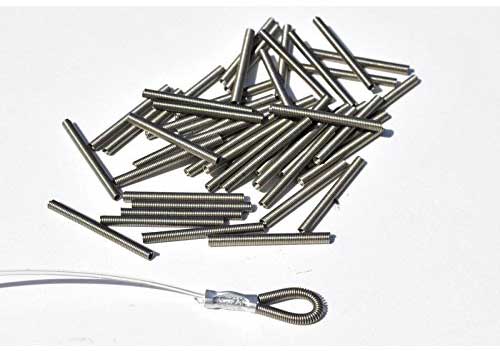
Buy from Amazon
Shop Bass Pro Shops
This chafing gear kit comes with 150 tubes. There are 25 tubes in size 1.2, 1.4, 1.6, 1.8, 2.0, and 2.3 mm and come with a clear plastic storage container. Bass Bro Shops has the classic green chaf tubes that can be cut to the desired lenght.
Chafing springs or tubes help prevent wear at the line connections when rigging multi-strand cable, fluorocarbon, or monofilament. Using springs, coated polyester braid chafe tubing, or plastic thimbles are all good ways to prevent lines from wearing through.
Trolling Lure: Sea Witch Rigged with Ballyhoo on a Planer
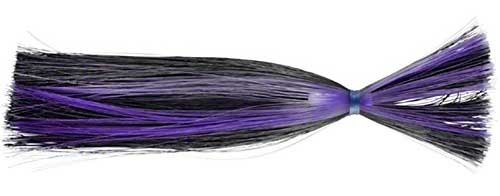
Buy from Amazon
Shop Bass Pro Shops
This sea witch is 1.5 ounces and has a black-purple nylon skirt. Other color options include black-red, blue-white, and pink-white. I love fishing with a sea witch on a planer rigged with a ballyhoo. When doing so I am always confident I will catch a wahoo if one is around.
Sea witch lures should be rigged with wire or cable and then rigged with a ballyhoo or strip bait. The lure needs to be used on a planer, downrigger, or with an inline weight. Fishing with a sea witch is typically done at a speed of less than 12 knots. This is a good way to target wahoo while also fishing for tuna and mahi-mahi.
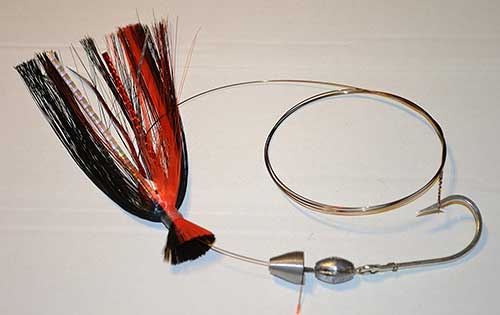
Buy from Amazon
This sea witch rig comes ready for ballyhoo. The wire is #9 105 pound test. A chin weight which is around 3/8 ounce is secured near the hook with rigging wire. The skirt color is rent and black and has a 1/2 ounce lead head.
A ballyhoo spring makes adding ballyhoo to this rig quick and easy. To rig ballyhoo, the hook is placed in near the gill and out the underside of the bait like normal. The weight should be tucked into the chin of the fish and the pin should be placed up through the mouth into the soft top lip. Next, the spring threads onto the pin until the bait is secure. Finally, the excess pin exposed should be cut with a wire cutter and the skirt placed overtop the bait. This rig should be trolled on a planner or downrigger at 7-10 knots.
High-Speed Trolling Planer

Buy from Amazon
A planer is used much like a downrigger on a boat. It is let out using a yo-yo hand spool and is then tied to the back cleat on the boat. The line is then sent down on a double snap swivel with a rubber band. This makes is so you can troll fast and get the lure below the surface. When retrieving the planer the boat should be slowed down and the line should be kept away from the propellers. It comes rigged with 35 feet of line at runs at about a 45-degree angle. This makes the max depth around 25 feet. This is a good depth for wahoo but a long line can be added to set lines deeper.
Yo-Zuri Bonita style lures, sea witches, and other bullet head skirt baits can be ran with a planer. If there is a downrigger on the boat these same methods can be used just make sure you have strong adjustable downrigger release clips.

Trolling Lure: Huntington Drone Spoon for Planer Fishing
If you do not have a planer off the back of your boat you can use a planner on a fishing rod. If you do not have ballyhoo for the sea witch you can use a drone spoon. So this is an alternative to the Sea Witch Rigged with Ballyhoo on a Plane.
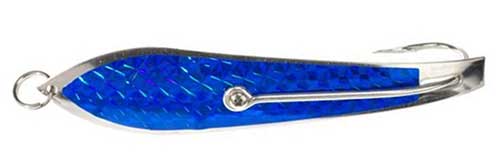
Buy from Amazon
Shop Bass Pro Shops
The Huntington drone spoon is 5-1/2 inches and weighs 1-1/8 ounces. It is rigged with a 10/0 Mustad J-hook. Color options include blue-silver, red-silver, silver-silver, and green-silver. Sizes of drone spoons range from 1-1/14 inches up to 8-1/8 inches.
Leaders are made with 50-100 feet of monofilament and then a short wire, cable, or fluorocarbon leader is added. For wahoo, I would recommend adding the wire or cable. Some people claim the fish rarely breaks off using 80-pound fluorocarbon but with wire, you know the fish will not cut the line. To stay organized the leaders are typically wrapped on yo-yo hand reels.
Sea Striker Size 4 Planer for Drone Spoon

Buy from Amazon
Shop Bass Pro Shops
The size 4 Sea Strike planer has a 4-ounce front weight and will run 15-30 feet deep. Unlike the size 8 planer that is tied off to the boat, this is an inline planer that is connected directly to the fishing pole. Bullet-head skirt baits, sea witches, and drone spoons are typically run 50-100 feet behind the planer.
The line from the fishing pole is connected to the front ring with a snap swivel and the leader is connected to the back of the planer with a quality ball bearing snap swivel.
Trolling Lure: Bost Wahoo Witch Trolling Lure

Buy from Amazon
The Bost #39 wahoo witch weighs about 7 ounces. Color options include blue-white, green-black, pink-blue, pink-white, purple-black, and red-black.
The lure can come unrigged or rigged with 3 feet of 490-pound cable with two hooks. This is the best-looking and heaviest sea witch-style lure on the market. Perfect for high-speed wahoo trolling. The hooks that come with the rigged version are not intended to be used with ballyhoo.
High-Speed Trolling for Wahoo
High-speed trolling can be utilized when traveling to and from fishing spots. Capable of reaching speeds of 60 mph, wahoo can easily hit lures traveling at 18 mph. When traveling in typical 2-4 foot waves, 18 mph is an average transit speed, so being able to fish for wahoo during these times makes good use of what would otherwise be wasted fishing time. Trolling this fast is not a trivial task however and heavy lures and big game reels with quality drag are required.
Early in the morning is a great time to troll for wahoo, so I often just set out a line during transit. It doesn’t always catch fish, but when it does, it’s a nice bonus fish for the day.
When high-speed trolling for wahoo, the drag is set so the lure resistance is just barely not pulling the line off the reel. When a fish strikes, the speed should be slowly backed off until the boat is at a slow troll speed but still moving forward. Keep the boat moving forward with a slight turn to keep the wahoo away from the motors. When using inline planers or trolling weights with shock lines, the leaders will need to be pulled in by hand. It’s nice to have two people for this process, one person to leader and the other to gaff the fish.
High-Speed Trolling Lure: Billy Baits Mister Big

Buy from Amazon
Billy Baits Mister Big lures are 16 inches long and have a 16-ounce head. This lure comes unrigged. Color options for the skirts are red-black, green-black, blue-white, and white-blue.
The head of the lure is a jet that makes large bubble trails under the water. This lure is intended to be used for high-speed trolling and works well with a 16-24 ounce inline trolling weight.
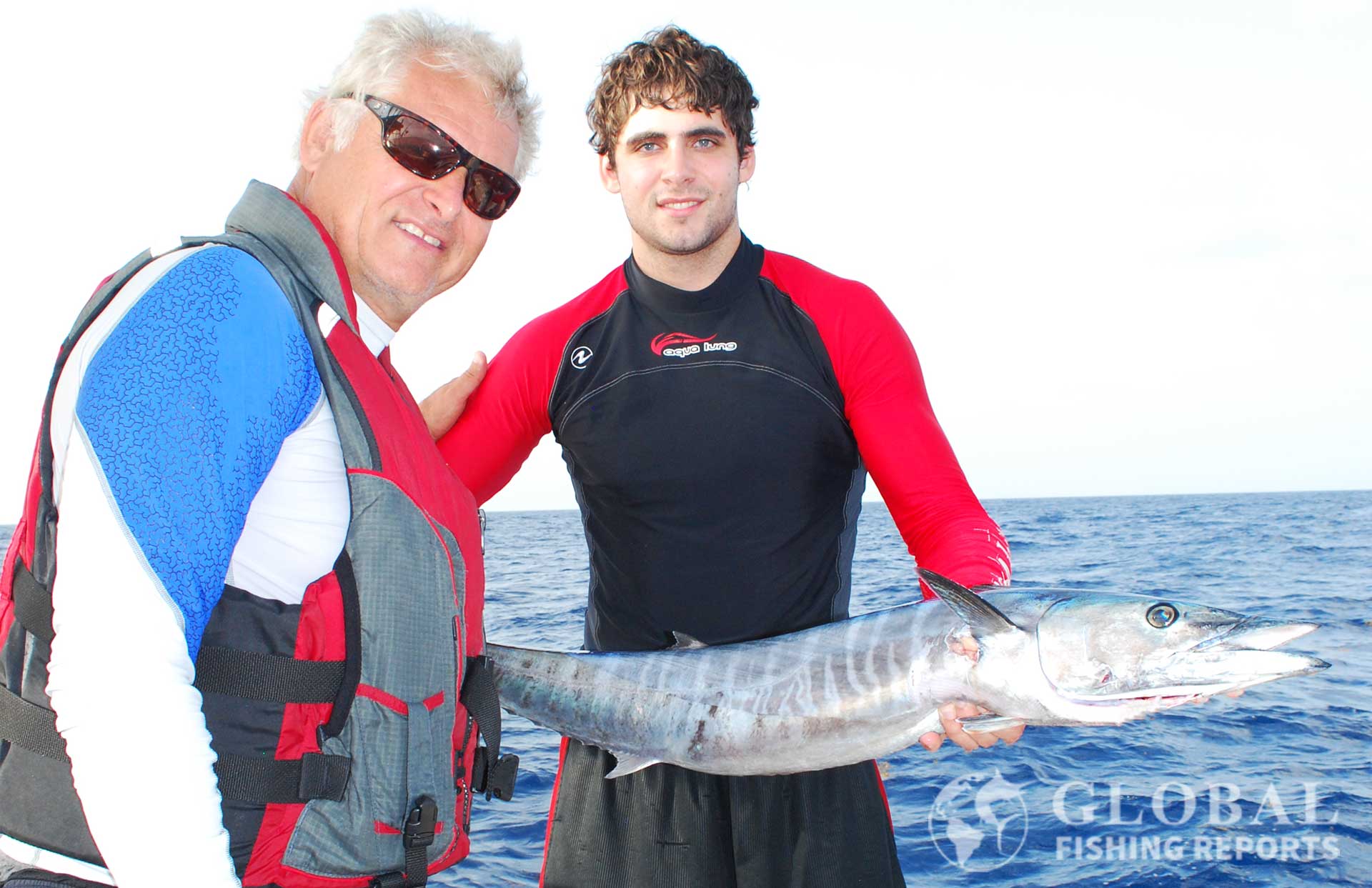
In the photo is my dad and brother with a nice wahoo that was caught in the Florida Keys.
High-Speed Trolling Lure: EatMy Tackle Slothead Jet
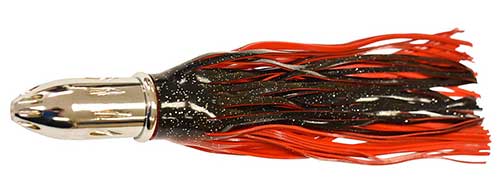
Buy from Amazon
This EatMy Tackle jet high-speed trolling lure is 24 ounces and 14-inches in length. It has 5 jets drilled trough the 3-inch head. The chrome-plated brass head comes attached with double skirts in colors of red-black or purple-black. This lure comes unrigged or rigged with a 400-pound stainless cable using an 11/0 double offset hookset. This lure is very similar to Billy Baits Mister Big lure. However, the Mister Big lure does not come rigged and is 16 ounces. When high-speed trolling 30-80 class conventional reels are needed.
With a 24-ounce head weight, this lure can be run really far back without needing an inline trolling weight. The jets create a great smoke trail to help get the attention of wahoo. This is one of the easiest lures to use while high-speed trolling. If the reel is spooled with 60-100 monofilament a shock leader is not even needed. For recreation fishermen, this is the easy way to fish for wahoo. Just stagger two 24-ounce lures way behind the boat and troll 14-18 knots and you should have success if there are wahoo in the area.

In the photo is a wahoo that just landed in the boat. It still has nice looking zebra stripes. These stripes go away quickly so get photos shortly after landing the fish.
High-Speed Trolling Lure: Black Bart
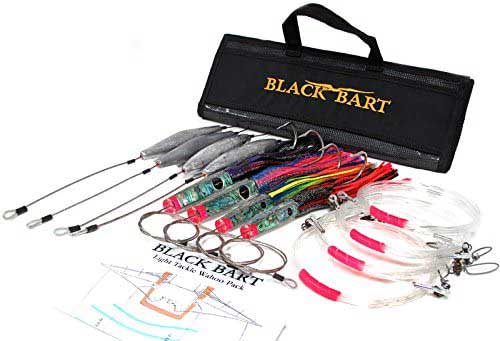
Buy from Amazon
Shop Bass Pro Shops
This Black Bart High-Speed Wahoo trolling kit comes with all the terminal tackle needed to make a great looking wahoo spread. It includes two Rum Cay Candy lures, two San Sal Candy lures, four 24 ounce trolling weights, and four 20 foot shock leaders that are 300-pound strength. A lure bag is also included to help keep the gear organized.
At first glance, this kit looks expensive but each wahoo setup is about $100 which is about what a good rig costs. When you factor in all the other expenses required for a successful fishing trip the lures are not a place to cheap out. These are quality rigs that many wahoo anglers recommend. These lures work with 30-50 class fishing tackle. Black Bart also has a package with 32 ounce trolling leads that work with 50-80 class tackle.
The video above shows the first wahoo I ever caught while high-speed trolling. I was very excited!
High-Speed Trolling Lure: Cowbell Style Wahoo Lures
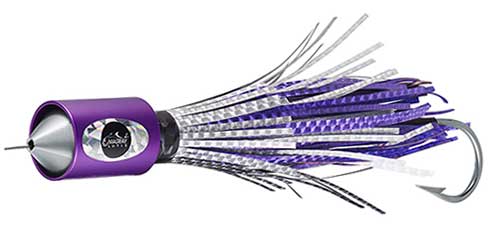
Buy from Amazon
This MagBay Sincero wahoo lure is 11 inches in length and weighs 16 ounces. A size 10/0 hook comes rigged on a 280-pound stainless steel cable. Color options include black chrome, blue anodized, blue iridescent, green anodized, pink chrome, purple anodized, purple chrome, purple iridescent, red anodized, and teal anodized. MagBay Sincero lures come in weights from 8 to 34 ounces.
As water flows through the head it wobbles back and forth creating a loud rattle noise. It also creates nice bubble trails. Many people in South Florida have great success with cowbell style wahoo lures like this one.
Inline trolling leads are not typically used with this style lure but instead, these are placed really far back. A 16 ounce Sincero works well at speeds up to about 14 knots and then a heavier lure is a better option.
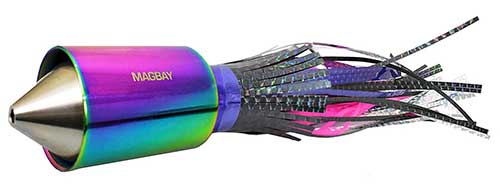
Buy from Amazon
This 34-ounce Sincero Sr is 16 inches in length. Three mylar skirts are used in addition to a rubber skirt to provide a large profile. This comes fully rigged on 480-pound multistrand cable and has a single 11/0 hook placed on a short 900-pound cable. The iridescent head with black mylar makes this look like a small tuna or Bonito.
Being 34 ounces this lure can be trolled up to 18 knots and does not need an inline trolling weight. This is very similar to the 32-ounce cowbell style lure that has been used for years. The head of the lure rattles and creates bubble trails that get the attention of wahoo.
High-Speed Trolling Lure: Mother of All Baits MOAB
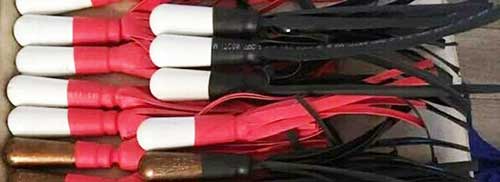
The wahoo MOAB or Mother of All Baits is a 2.5-pound wahoo lure that is 17 inches in length. These can be found on eBay for about $70 each unrigged. Color options are white-red, white-black, brown-red, and brown-black. The heavy weight of this lure makes it so it can be used without an inline trilling weight.
Trolling Lure: Chin Weighted Mullet Rig
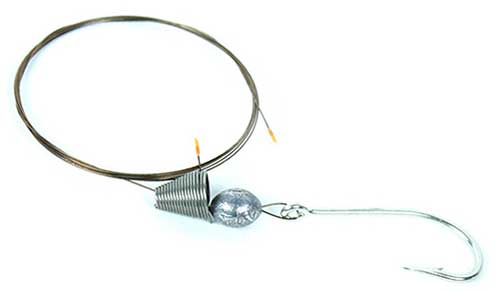
Buy from Amazon
Trolling with chin weighted mullet is a unique way to troll for wahoo. Mullet can be trolled with or without a skirt, on a planer, downrigger, inline weight, or at the surface. Typical troll speeds are 5-8 knots when using mullet. This can be an effective way to catch wahoo if the fish are concentrated in a particular area.
The rig above is a wire ballyhoo rig that can be used with almost any bullet head shape skirt lure to catch wahoo. The #9 single-strand wire used has a 105-pound test. Hook size options are 7/0 and 8/0. It comes with a ballyhoo bait spring and a chin weight around 3/8 ounce.
The ballyhoo can be secured with a bait spring, rubberband, or rigging wire. A chin weight acts as a keel weight so the ballyhoo runs upright. Ballyhoo is the most popular bait to run for wahoo and mullet is the second most popular bait.
Trolling Lure: Rapala X-Rap Magnum Lure

Buy from Amazon
Shop Bass Pro Shops
This Rapala X-Rap Magnum 30 is 6.25 inches and weighs 2-1/2 ounces. The running depth is 15-30 feet at speeds up to 13 knots. There is also a magnum 40 which is 7-inches in length and weighs 3-3/8 ounce. It is designed to run up to 40 feet deep at speeds up to 13 knots.
The actual running depth will vary based on fishing line thickness speed and amount to line let out. Hot pink, bonito, dorado, and silver are good color choices. These lures also works well to catch mahi-mahi, tuna, barracuda, and king mackerel.
Other Lure Options For Wahoo
High-Speed Trolling Lure: Nomad Madmacs
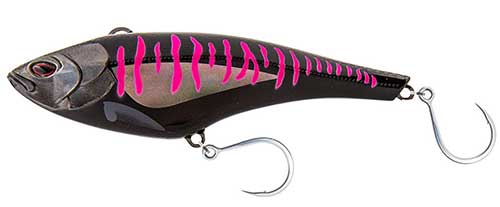
Buy from Amazon
Shop Bass Pro Shops
The Nomad Madmacs is a sinking high speed trolling lure. Three size options are available. The Madmacs 160 is 6 inches in length, weighs 9 ounces, and dives 4-12 feet deep. Madmacs 200 is 8 inches in length, weighs 11.5 ounces, and dives 4-15 deep. Finally, the Madmacs 240 is 10 inches in length, weighs 13.5 ounces, and dives 4-15 feet deep. All of these can be trolled at 5-20 mph.
Color options include black-pink mackerel, hot pink mackerel, orange mackerel, phantom, sardine, silver-green mackerel, and Spanish mackerel. A stainless steel plate runs through the lure for extra strength. The autotune system helps create vibrating action at both low and high speeds. It also allows the lure to track straight at extremely high speeds for a lure beneath the surface.
High-Speed Trolling Lure: Yo-Zuri Vibe

Buy from Amazon
Shop Bass Pro Shops
The Yo-Zuri high-speed vibe is 5-1/4 inches long and weighs 2-7/8 ounces. These lures have patented color change technology. Color options include bonita, bunker, chrome sardine, dorado, holographic black, blue, pink, mackerel, and orange black. The treble hooks are 3 extra strong and connected with through wire connection in the body of the lure.
This is a fast sinking lure that can be trolled up to 15 knots. The lure can also be cast and retrieved or vertically jigged in open water. This lure can also be fished like a blade bait used for bass fishing. In that case, the lure fluttering up and down in the water column can encourage strikes.
High-Speed Trolling Lure: Wahoo Eliminator

Buy from Amazon
The Wahoo Eliminator is 13 inches long with a 24-ounce head, 400-pound cable, and two offset 10/0 hooks. This is my favorite lure to use when high speed trolling for wahoo. This is because it weighs over 2 pounds and can be trolled without adding inline weights. Red and black is great color skirt for wahoo fishing as well.
A skirted squid bait with a heavy lead head is the easiest way to get started fishing for wahoo. Attach the rig to a hefty pole and a 30-80 class reel and you are ready to go wahoo fishing. A 50 class reel is a great size! Troll speeds of 12 to 18 mph are typically used with the lure 400 to 600 feet behind the boat.
Ideally, the lure is really far back and under the water where it can be most visible to fish. If the lure surfaces occasionally that is fine as long as it is under the water most of the time. When fishing for wahoo in transit one or two poles can be quickly set out. If targeting wahoo for the day as many as six lines can be used. If the reel is spooled with a braided line using a shock leader is a good idea and will discuss below.
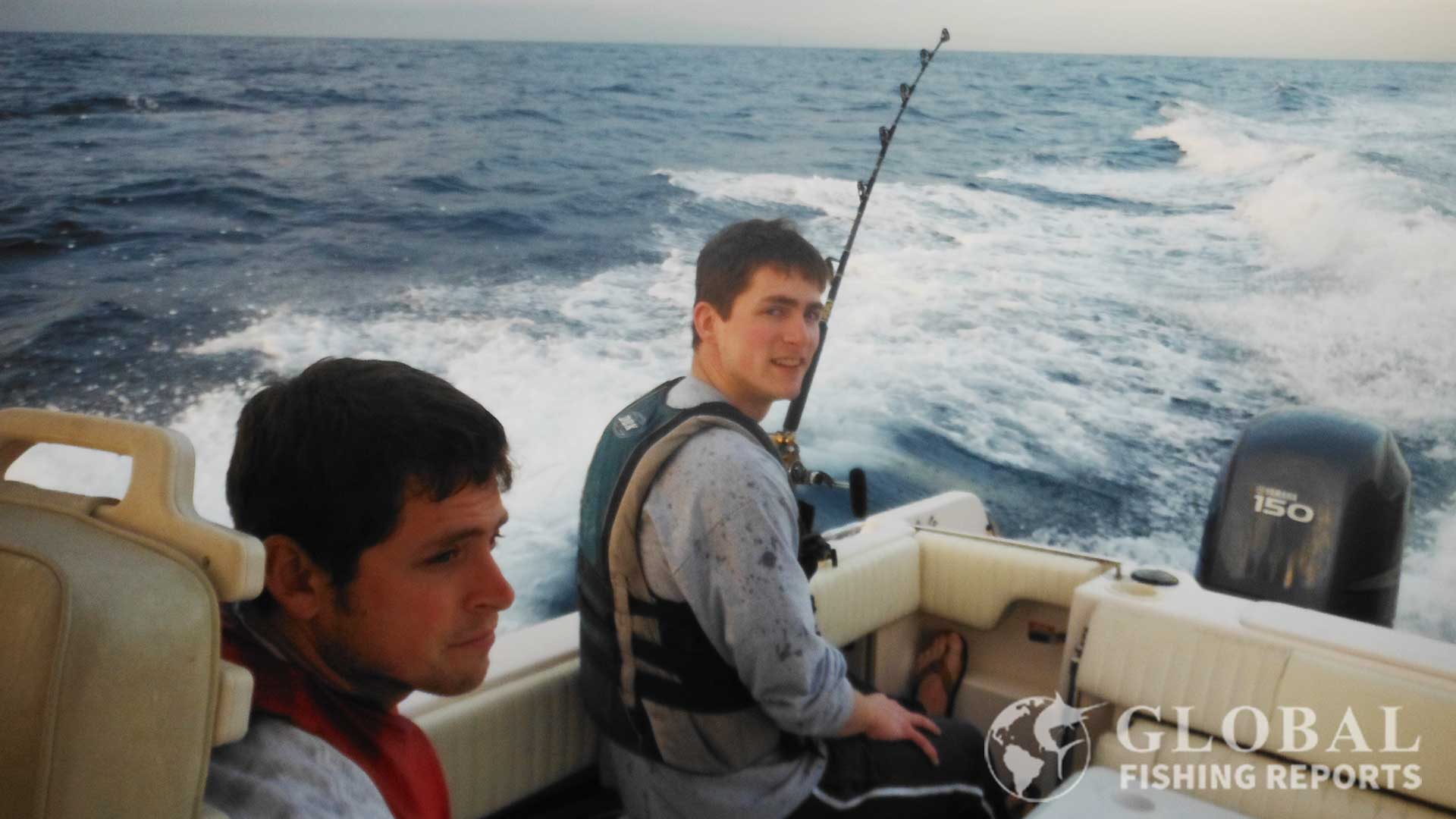
In the photo, my brother and I are high speed trolling for wahoo. We are actually running about 30 miles offshore. Early in the morning is a great time to troll for wahoo so we just set out a line during transit. It does not always catch fish but when it does it is a nice bonus fish for the day.
High-Speed Trolling Lure: Bost San Sal Wahoo Lure
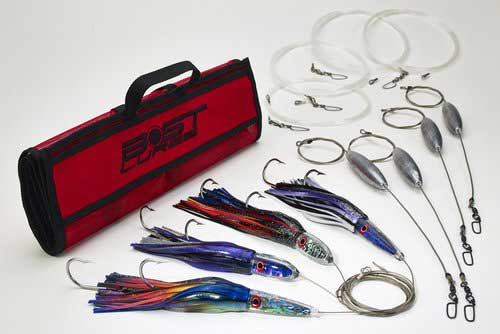
Buy from Amazon
The pack includes four pre-rigged setups. This comes with two Bost San Sal #36 which are 8 ounces and 13 inches long two and two Bost The Bullet #80 lures which are 8 ounces and also 13 inches long.
Two of the trolling weights are 24 ounces and two of the trolling weights are 32 ounces. These are rigged with 10/0 double hooks on a 490-pound steel cable. This pack includes everything you need to make great looking wahoo lure spread. Hopefully, your boat and fishing reels can troll this great gear.
Notice the shock leaders which are a good idea when trolling for wahoo with braided line. This line is placed between the inline trolling lead and the lure. This helps the setup have some stretch when the wahoo first bites. If you are running without the added weight and are using a braided line it is still a good idea to add a shock leader line before the lure.
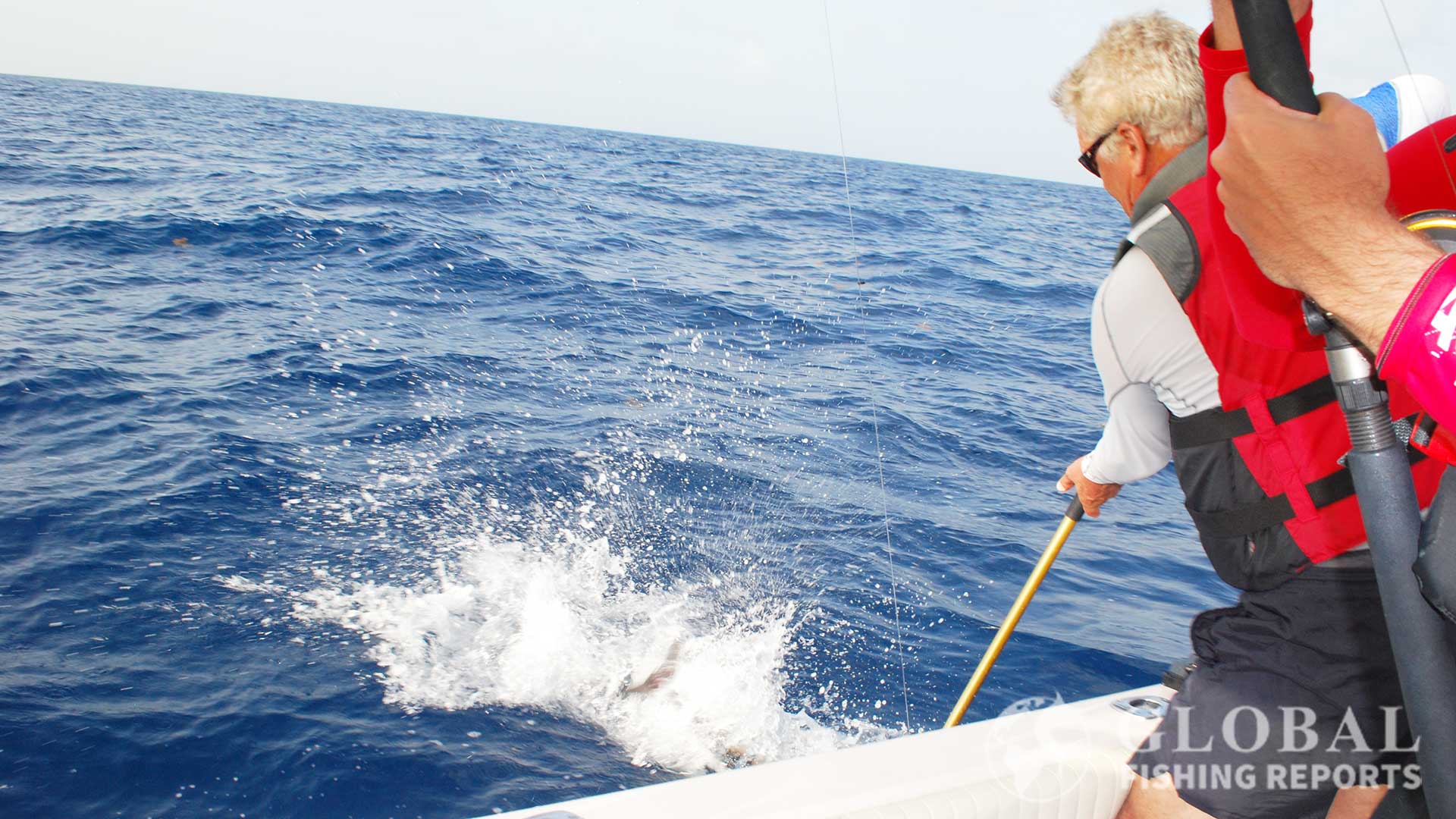
In the photo, my dad is gaffing a wahoo. Some fishermen are picking and try and near the gills of the fish to not hit the meat. If the fish is not tired out yet that is more easily said then done.
High-Speed Trolling Lure: Bahama Big Eye
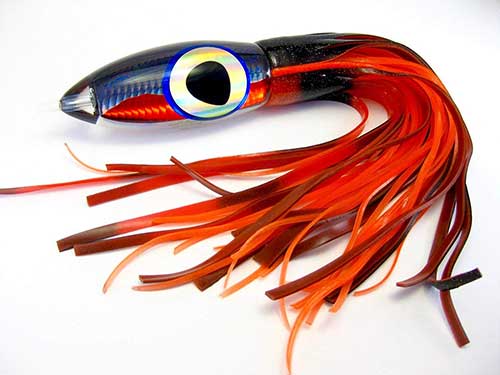
Buy from Amazon
This is a 15-inch wahoo lure and weighs 8 ounces. The large eye is encased in the urethane head. Color options include red-black, red-eye, turquoise, blue-pink, blue-white, lime-green, orange-black, pink, and purple.
The lure is rigged with 480-pound cable and double non-offset hooks. This lure was used to catch the largest weighed in wahoo ever caught in the Bahamas. It weighed 162 pounds. The IGFA world record for wahoo is 184 pounds and was caught in Cabo San Lucas, Mexico.
Jigging for Wahoo
Most wahoo that I have seen caught were done so using trolling techniques with lures in the top 50 feet of water. Jigging for Wahoo is a lot more work but is a challenge that many serious wahoo anglers enjoy.
A good place to jig for wahoo is in depths up to 500 feet around structures such as wrecks, reefs, humps, or under sargassum weed and debris that is holding mahi-mahi. When fishing these areas, always be checking the finder for fish in the top 100 to 500 feet of water. If a fish or a large amount of bait is marked, it is worth jigging.
Jigs: Shimano Butterfly flat-fall jigs

Buy from Amazon
Shop Bass Pro Shops
Shimano Butterfly flat-fall jigs have sizes that range from 2-3/4 ounce to 11.5 ounces. Good color options include black anchovy, black silver, chartreuse silver, phantom squid, green silver, purple silver, white silver, and zebra glow. Bass Pro Shops lists a very similar Freestyle vertical jig.
A 4-ounce jig is good for water depths above 100 feet, a 6-ounce jig is good for 100-200 feet, and an 8-ounce jig is good for water deeper than 200 feet. These jigs are typically dropped with no resistance in a free fall for 60-90 seconds. The jigs are then retrieved with fast pulls upward and a brief pause while reeling down the slack. Make sure that a fast retrieve spinning reel is being used.
Jigging in areas that also hold tuna, kingfish, sailfish, and amberjack is a good idea because there will likely be more action. Jigging is often done in combination with chunking over wrecks and deep reefs when anchored up and when flying kites for fish near the surface.
Jig Assist Hooks with Wire Cable
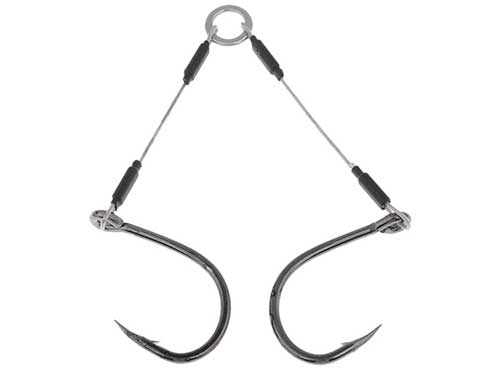
Buy from Amazon
Wire assist hooks are needed to protect against the teeth of wahoo when jigging. A short wire leader is also a good idea because fish almost always strike the jig head first and the line is tied near the eye which is where the hooks should be as well. A short 6 to 12-inch number 7 wire which is a 69-pound test is all that is needed.
Using wire assist hooks is important and needed when jigging for wahoo. Some people say that you get fewer bites when using wire assist hooks. However, normal hooks are attached with thick rope-like string that is also quite visible. I have had polyethylene assist hooks get cut off by fish many times. I always wished I had wire assist hooks when that happens. If a bigger fish eats your fish on the way up having wire and wire assist hooks will give you a good chance of catching it unless the jigging rod and reel can not handle it!
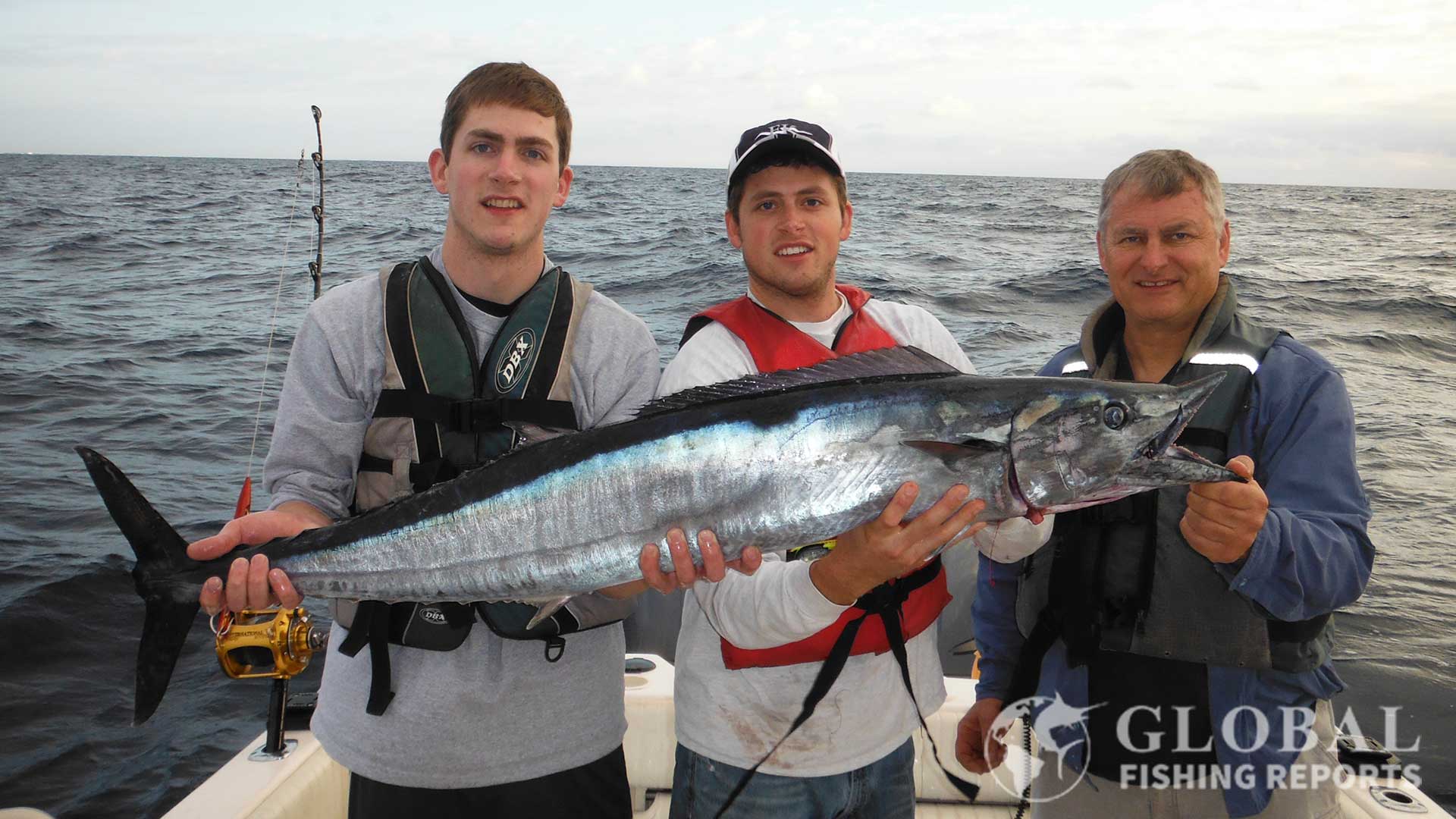
In the photo is a wahoo caught in the Florida Keys. This was several minutes after the catch and you see the wahoo lost its stripes.
Rigging for Wahoo
Leader Material and Hooks
Wire assist hooks are needed to protect against the teeth of wahoo when jigging. A short wire leader is also a good idea because fish almost always strike the jig head first, and the line is tied near the eye which is where the hooks should be as well. A short 6 to 12-inch number 7 wire which is a 69-pound test is all that is needed.
When high-speed trolling for wahoo, rigs are made with 500-pound multistrand cable with 8/0-11/0 single or double hook rigs. When trolling slower between 5-10 knots, bullet-shaped nose skirt baits and sea witches can be rigged with ballyhoo. The ballyhoo can be secured with a ballyhoo spring, rubber bands, or rigging wire. Single-strand wire or multi-strand cable can be used for leader material.
Using Shock Leaders
Shock leaders are a good idea when trolling for wahoo with braided line. This line is placed between the inline trolling lead and the lure. This helps the setup have some stretch when the wahoo first bites. If you are running without the added weight and are using a braided line, it is still a good idea to add a shock leader line before the lure.
Best Locations and Seasons for Wahoo
Where to Find Wahoo
There is good wahoo fishing from the canyons of New Jersey all the way to the Florida Keys, Bahamas, and the Caribbean. Other popular spots include deepwater oil rigs in the Gulf of Mexico in the wintertime. In the Pacific ocean, wahoo are frequently caught in Hawaii, Central America, and occasionally as far north as southern California.
Best Seasons for Wahoo
Wahoo in the canyons off the East Coast can be caught from early spring and into the fall. In Florida and in the Caribbean, the best time to catch wahoo is in the winter. In Central America, wahoo can be caught year-round but are nearshore in the summertime months of May-August and are in blue water during the winter months.
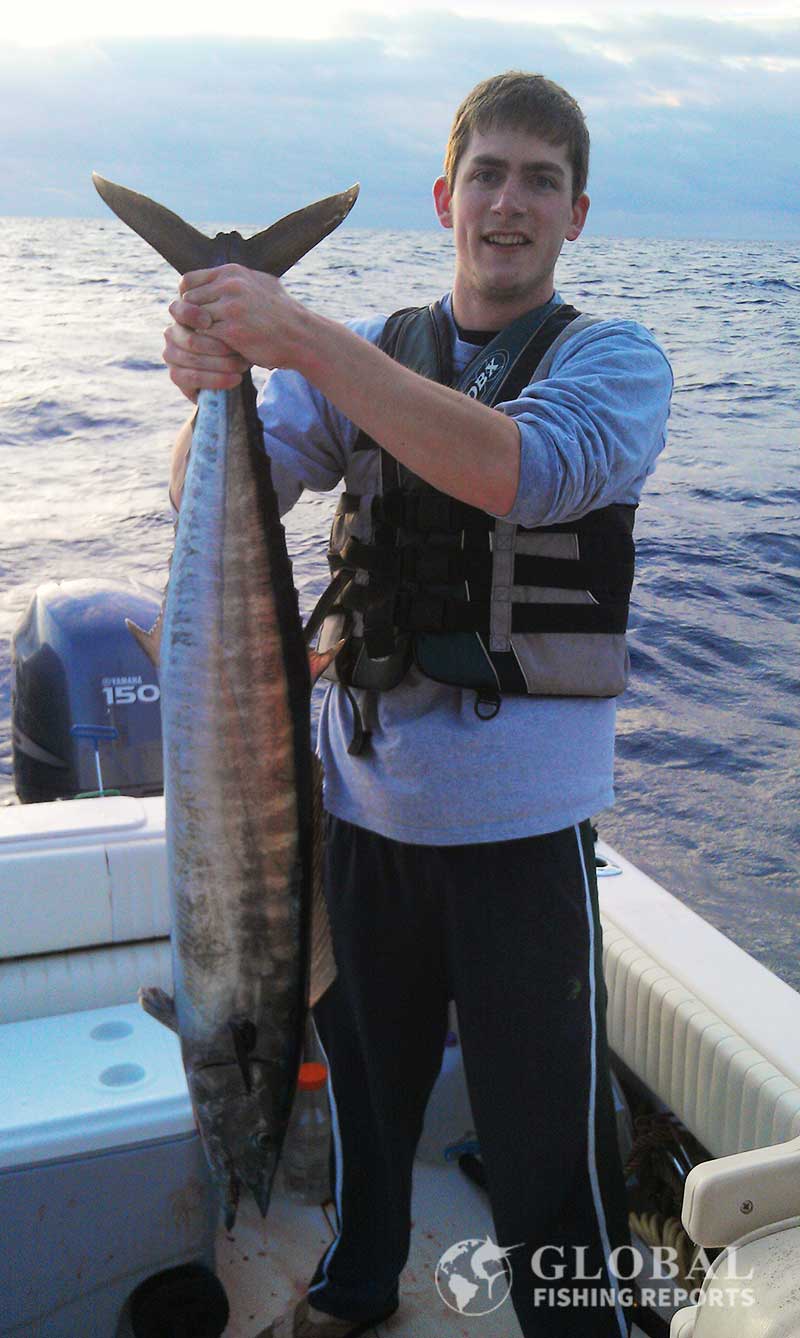
Wahoo Facts and Handling
How Fast Do Wahoo Swim?
Wahoo can swim up to 60 miles per hour. It is common to catch wahoo when trolling at speeds of 18 mph. Wahoo are good fighters when caught on medium to light tackle. If you hook a wahoo on a light tackle setup, do increase the drag to the point that it might break the line. Wahoo make several hard fast runs but then get tired and can be reeled in much easier. Even with 50 class reels, the drag should be set around 30 pounds.
Wahoo as Table Fare
Wahoo is in the mackerel family but tastes way better than any mackerel. It is an expensive, highly desirable meat that is typically priced over $30 a pound. Wahoo should be cooked and not eaten as sashimi because of possible parasites. Some people risk it, but why take the chance when it tastes so good cooked. When cooked, wahoo meat is white and firm, similar to a quality tuna steak.
Handling Wahoo After Catch
In my experience, wahoo have beautiful zebra stripes when first caught, but these stripes fade quickly after landing. If you want to capture the striking pattern in photos, be sure to take pictures shortly after landing the fish.
When gaffing a wahoo, some fishermen are picky and try to place the gaff near the gills of the fish to not hit the meat. If the fish is not tired out yet, that is more easily said than done.
Captain Cody has worked on charter fishing boats in the Florida Keys, Virgin Islands, and Alaska. Growing up in Pennsylvania Cody has also done extensive freshwater fishing including bass fishing tournaments. Cody strives to provide detailed information about the best fishing gear and tactics to help both novice and experienced anglers have a more productive and enjoyable time on the water. Cody also has a background in aerospace engineering and neuroscience but really only takes pride in being good at one thing and that is fishing!
How to Catch Mahi-Mahi: Fun and Effective Methods
My favorite type of fish to catch is, “mahi-mahi baby”! That is what we usually say during the excitement of catching mahi-mahi. These are tropical fish that seasonally migrate thousands of miles each year. Mahi-mahi are also called the dolphinfish or dorado in Portuguese.
These bright-colored carnivores are the fastest-growing fish in the world, growing up to 1 inch per week and gaining up to 3 pounds per month. Mahi-mahi live in surface waters and eat fish, crabs, squid, and shrimp.

Where to Find Mahi-Mahi
Mahi-mahi are found scattered in the open ocean generally in warmer waters near the gulf stream. The general strategy to find mahi-mahi in South Florida is to travel past the reef into blue water 200 feet or deeper in-depth but the mahi-mahi will be near the surface. Upon reaching blue water look for Sargassum Alge weed lines, debris, fish surfacing, or diving birds. Once one of these is found there is a good chance mahi-mahi will be around if it is the correct time of year. When fishing for mahi-mahi it is also common to catch sailfish, marlin, tuna, tripletail, and wahoo.
Effective Trolling Techniques for Mahi-Mahi
Once a good fishing location is found the baits can be pitched or trolled close to surface structure or activity. A six to seven-mph troll speed is typical for mahi-mahi. This can vary based on weather conditions, types of lures, and the size of the boat. Some lures need to be in locations fish can easily spot them. This is done by placing them far back or outside of the turbulence area of the wake. Mahi-mahi can swim at over 55 mph so don’t be afraid to try faster-trolling speeds if fish are not hitting lures at slow trolling speeds.
Some boats catch three mahi-mahi all day and others catch 60 mahi-mahi. The big difference is capitalizing once one fish is caught while trolling. Keep the fish in the water about 20 feet behind the boat until a second mahi-mahi is hooked. The second mahi-mahi should be caught by pitching a ballyhoo hooked through the nose close to the other mahi-mahi that is on the line. Once a second mahi-mahi is hooked the first mahi-mahi can be brought in. This cycle is repeated until the school of mahi-mahi leave. If the school is close to the boat a whole dead squid is a great pitch bait to use.
Bait Selection Strategies
Dead bait is typically all that is needed to pitch to the mahi-mahi but if the school of fish is not biting switching to live bait such as goggle eyes, cigar minnows, or pilchards is a great option to have. Once live bait is used that particular school of mahi-mahi may not bite dead bait anymore so it is a good idea to start out pitching dead bait. Some days the mahi-mahi are skittish and picky with baits and other days they will bite an empty hook!
There are lots of great lures and baits for mahi-mahi. In some locations, additional attractants are added to the trolling setup such as hookless spreader bars and dredges. Having good mahi-mahi trolling lures on board is very important so the first fish can be hooked which then keeps the school close to the boat. Pitch baits can then used to catch lots of fish very quickly.
Mahi-Mahi Lures and Trolling Setup
1. Captain’s Choice Fishing Mini Chugger
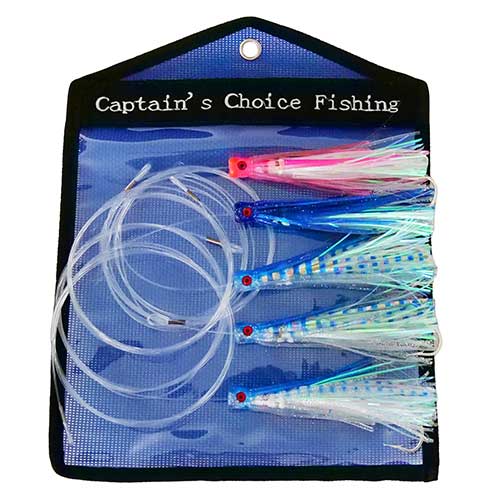
Buy from Amazon
Captain’s Choice mini chuggers have an overall length of 5-inches and come in colors of blue/clear with glitter, blue/white with glitter, and pink/white. These come pre-rigged in packs of five. I am always amazed at how well these lures work. It will catch the little schoolie mahi-mahi as well as huge marlin. If you ever ask a charter captain about mini chuggers you will usually hear something about catching marlin on a tiny lure. The mini chugger itself is only 3.5 inches long but a squid and duster are included which makes the overall lure length about 5-inches.
These lures work well to target mahi-mahi, tuna, marlin, sailfish, jacks, barracuda, mackerel, and wahoo. Mini-chuggers pick up fewer weeds than most baits which is one reason I love fishing with them.
Custom Mini Chugger Trolling Lure
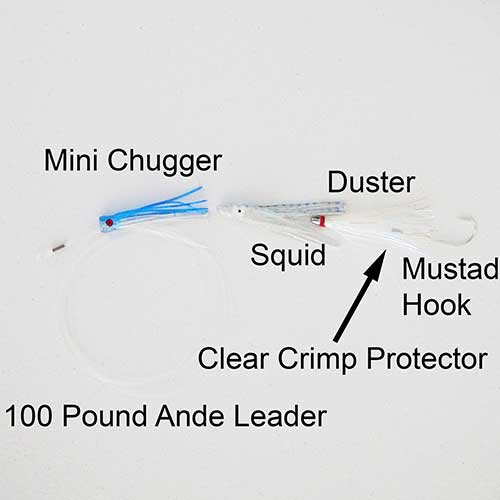
Mini chuggers used alone work ok but with a squid, pearl duster, and crimp protector these lures work even better! Adding the squid skirt and twinkle skirt duster adds color, flash, and weight to the lure. The added weight gets the chugger a bit deeper into the water making it more visible to the fish and allows it to create awesome bubble trails.
These squid skirts are 4.5 inches in length and the dusters are around 4 inches in length. The hooks are 7/0 Mustad 3407DT. A 100-pound 6-foot leader line is rigged with Ande Premium Line, chaffing gear, and crimp protector. This is exactly how I would rig up this lure as a charter captain. I prefer to run this lure a mid-distance behind the boat or on the longs, which for mahi-mahi is still not super far back.
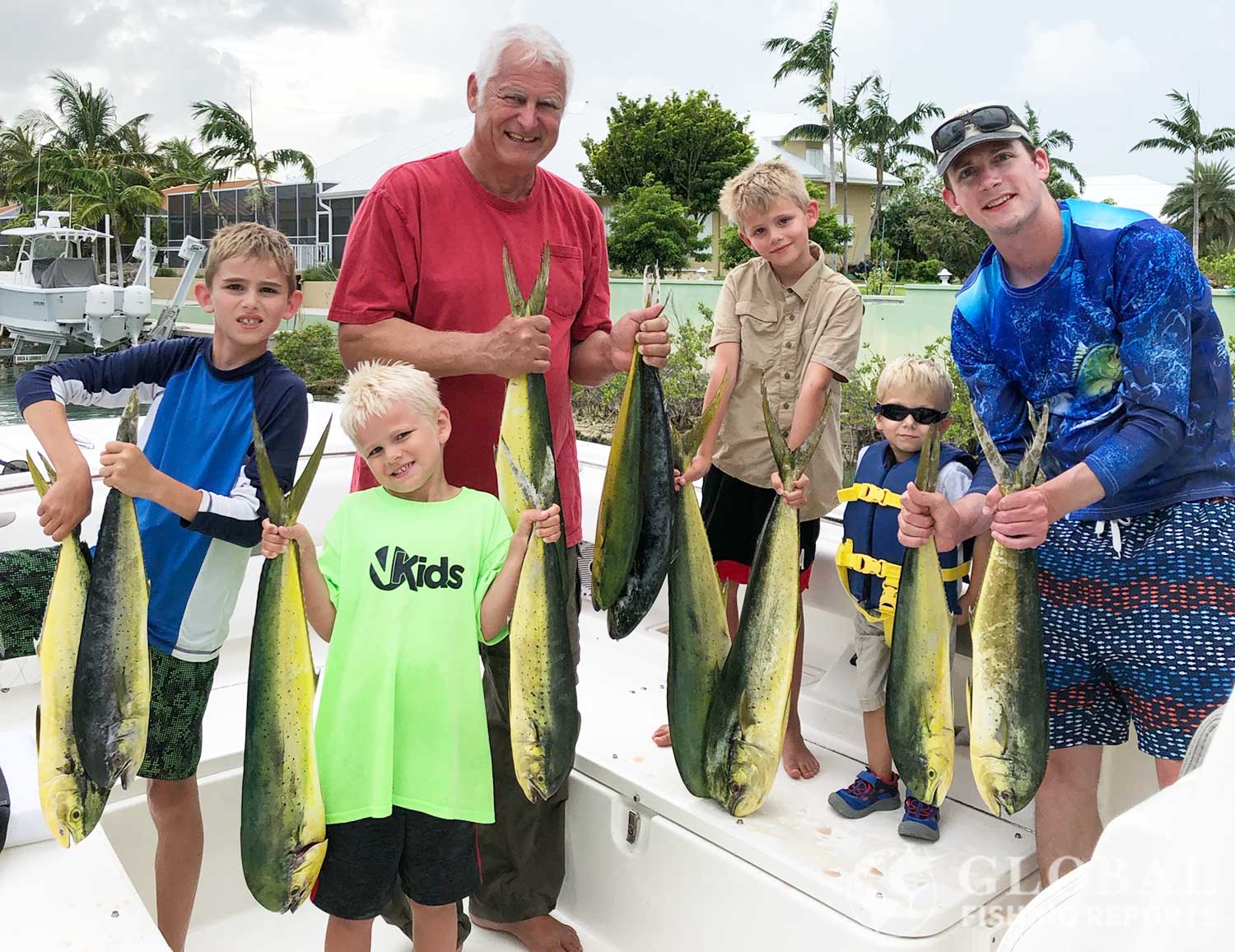
2. Chugger Head Mahi-Mahi Lure
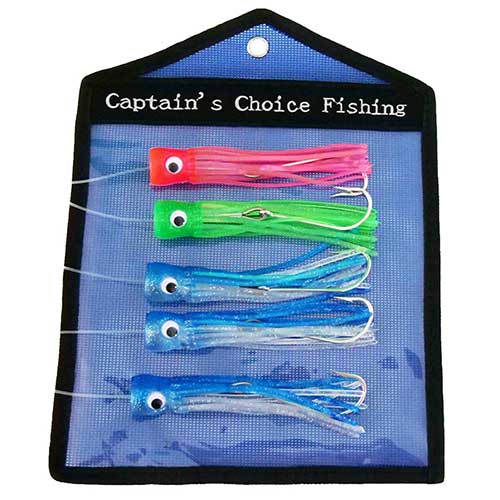
Buy from Amazon
These fully rigged chuggers are six inches in length and have soft pusher heads. The colors included are blue-clear with glitter specs, green with glitter specs, and pink. These come pre-rigged with a 150-pound leader line and number 8/0 Mustad hooks. These will work great to catch small schoolies and large slammer-size mahi-mahi.
Chuggers and mini chuggers are my favorite lures to use for mahi-mahi. They can be used right in the prop wash 15 feet behind the boat or on mid-distance lines set out on outriggers. These work well without being rigged with ballyhoo but are a common skirt to place over ballyhoo. The chugger head is concave like a popper and makes noise, splashing action, and creates great bubble trails. When going offshore there should definitely be some chuggers on the boat. A great thing about these lures is they pick up fewer weeds than most trolling lures. They will defiantly still pick up weeds but not as many as heavy lures. If weeds are a major issue then run the lines closer behind the boat and slow down a bit so there is less engine turbulence.
In the video above I talk about how to catch mahi-mahi. This includes both trolling techniques and how to pitch to mahi with live bait and dead bait. The lures I am using include a chugger, mini-chugger, chugger daisy chain, nomad dtx minnow and little stubby. Good baits include ballyhoo, greenbacks, pilchards, goggle eyes, cigar minnows, and squid.
3. Daisy Chain Chugger
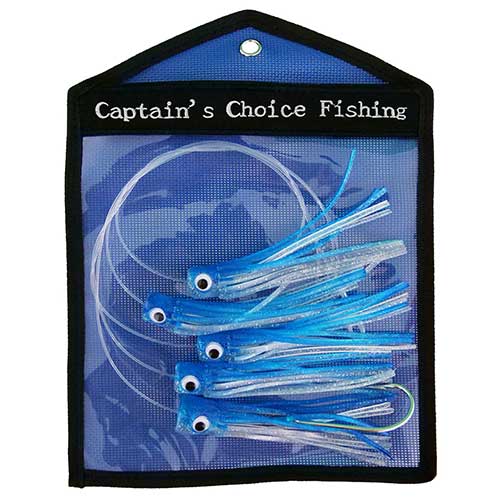
Buy from Amazon
The Captain’s Choice Fishing daisy chain is a great lure and teaser for mahi-mahi. I like to use it as a teaser that is trolled a bit closer than the other lures. It is not just a teaser though as the last chugger has a hook. Mahi-mahi are aggressive fish and will bite baits very close to the boat, even when trolling.
This lure is rigged with a 200-pound line with means that it can catch the big bulls without breaking. Each chugger is 6 inches in length and even small schoolies will bite the lure. Running the lure short limits the number of weeds that get caught on the line. Typically I set this close and it is the only lure that does not catch weeds when switching sides of the weed lines. The blue clear with glitter specs is a great color and looks a lot like a flying fish.

My nephew caught both of these nice bull mahi-mahi in July in the Florida Keys. One was caught on a blue/clear chugger and the other was caught on a piece of pitch bait.
4. Classic Offshore Trolling Lure

Buy from Amazon
These classic trolling lures are 6 inches in length. Colors included are three blue-white lures and two black-red lures.These come rigged on a 6-foot 100-plus pound Ande line rigged with 8/0 Mustad 3407DT hooks. A blue mesh bag is included to store the lures. If you are trolling offshore and not sure which lures to used this is a great option. The lures troll well at most speeds and can catch mahi-mahi, tuna, sailfish, marlin, jacks, mackerel, barracuda, and wahoo.
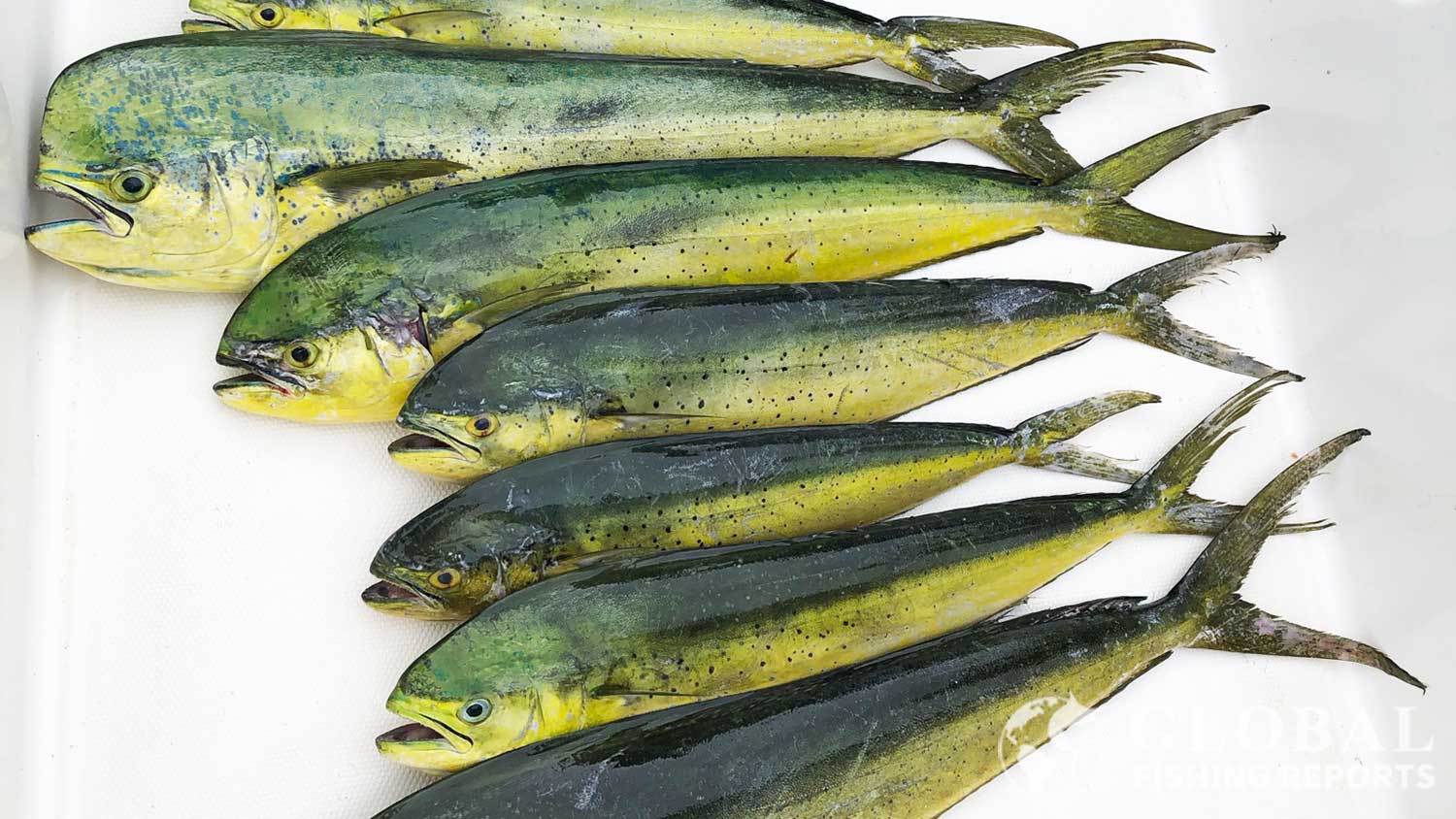
In the picture, is one bull dolphin and several female cow dolphin. These were caught offshore in the Florida keys.
5. Flying Fish Daisy Chain
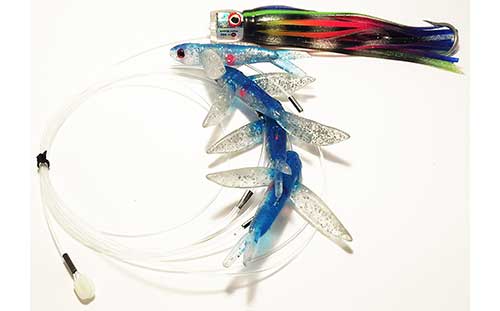
Buy from Amazon
The mahi-mahi daisy chain has a 6.5 inch Bost 63 Mahi Snack skirted lure with 4 flyers. This comes rigged on a 200-pound mono leader with a 6/0 heavy duty hook.
Having a daisy chain out while trolling offshore help helps attract fish into the spread and is frequently the first lure to get hit. Smaller daisy chains are typically put way back in the shotgun position. This daisy chain would work in the shotgun or on a line set a midway distance back on an outrigger. Flying fish are a favorite food of mahi-mahi and this daisy chain is a great flying fish imitation bait. This lure works as a small teaser that also catches fish.
The video above shows a common dynamic found fishing offshore for mahi-mahi. Frigate birds follow mahi-mahi until they spook flying fish out of the air. The frigate birds then swoop down and eat the flying fish. Frigate birds do not have oily feathers and can not get wet or they can drown. This is why they wait for baitfish to be brought within scooping distance of the surface.
If frigate birds are high they are either looking for fish or following fish that are not actively feeding. When they hover low to the water or are swooping near the surface there is likely mahi-mahi feeding underneath the fish. In Florida mahi-mahi usually feed swimming into the gulf stream which flows to the north. This means if a frigate bird is flying to the south it is also more likely following mahi-mahi.
Chasing birds is fun but not a guaranteed catch. Sometimes the fish are scattered and the birds are traveling so fast that you can not catch them even at a nine or ten-knot troll speed. This could mean that mahi-mahi are chasing scattered bait or that the frigate bird is following, bonito, tuna, or in the worst-case porpoises. Low slow-moving birds are the best and slowly trolling by them and pitching ballyhoo underneath and slightly in front of them has a high chance of catching mahi-mahi.

In the picture, is mahi-mahi and tuna that were caught while trolling and pitching live baits. These were caught about 20 miles offshore at the famous North Drop of St. John in the United States Virgin Islands. The North Drop is an underwater ledge that goes from 300 feet deep to 29,000 feet deep in just a few miles. In the summer this is a very popular place to fish for blue marlin.
6. C and H Little Stubby
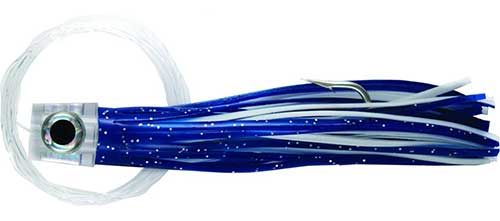
Buy from Amazon
Shop Bass Pro Shops
The C and H Little Stubby is 5-1/2 inches and weighs 2 ounces. The color options include blue-white or pink-white.
This lure is lightweight which makes it good a staying weed-free and works at any distance behind the boat. It probably works the best when set far behind the boat. The lure does not look that great in my opinion by it consistently catches fish. This lure is very similar to the Williamson Dorado Catcher that I will review later in this article. I have had good luck with little stubbies so that is what I typically use. These also catch lots of small tuna.
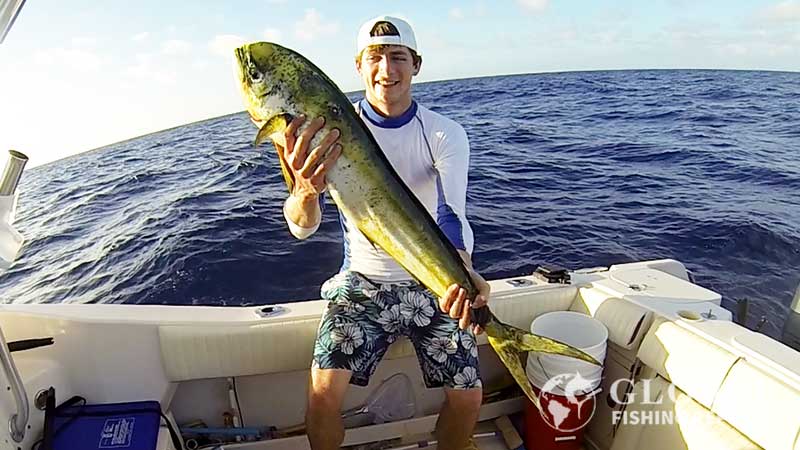
In the picture, I am holding a female cow mahi-mahi. This was caught on a blue and white little stubby while trolling along some weeds about 20 miles off the coast of the Florida keys.
7. C and H Stubby Bubbler
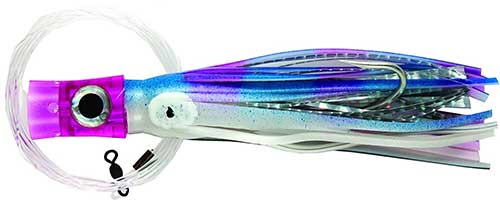
Buy from Amazon
Shop Bass Pro Shops
This C and H stubby bubbler comes in pink or purple, blue, white and has silver mylar within the skirt. The lure is 5 1/2-inches in length. Stubby bubblers come in a variety of other colors including, green-chartreuse, pink-blue, and pink-white.
This stubby bubbler can be run any distance behind the boat and will always create fantastic looking bubble trails. This lure has a plastic head and is lightweight which makes it great for staying weed-free. This lure also catches tuna, sailfish, and marlin so it is a great lure to have in the spread when fishing offshore! A strip bait can be added for scent but is certainly not
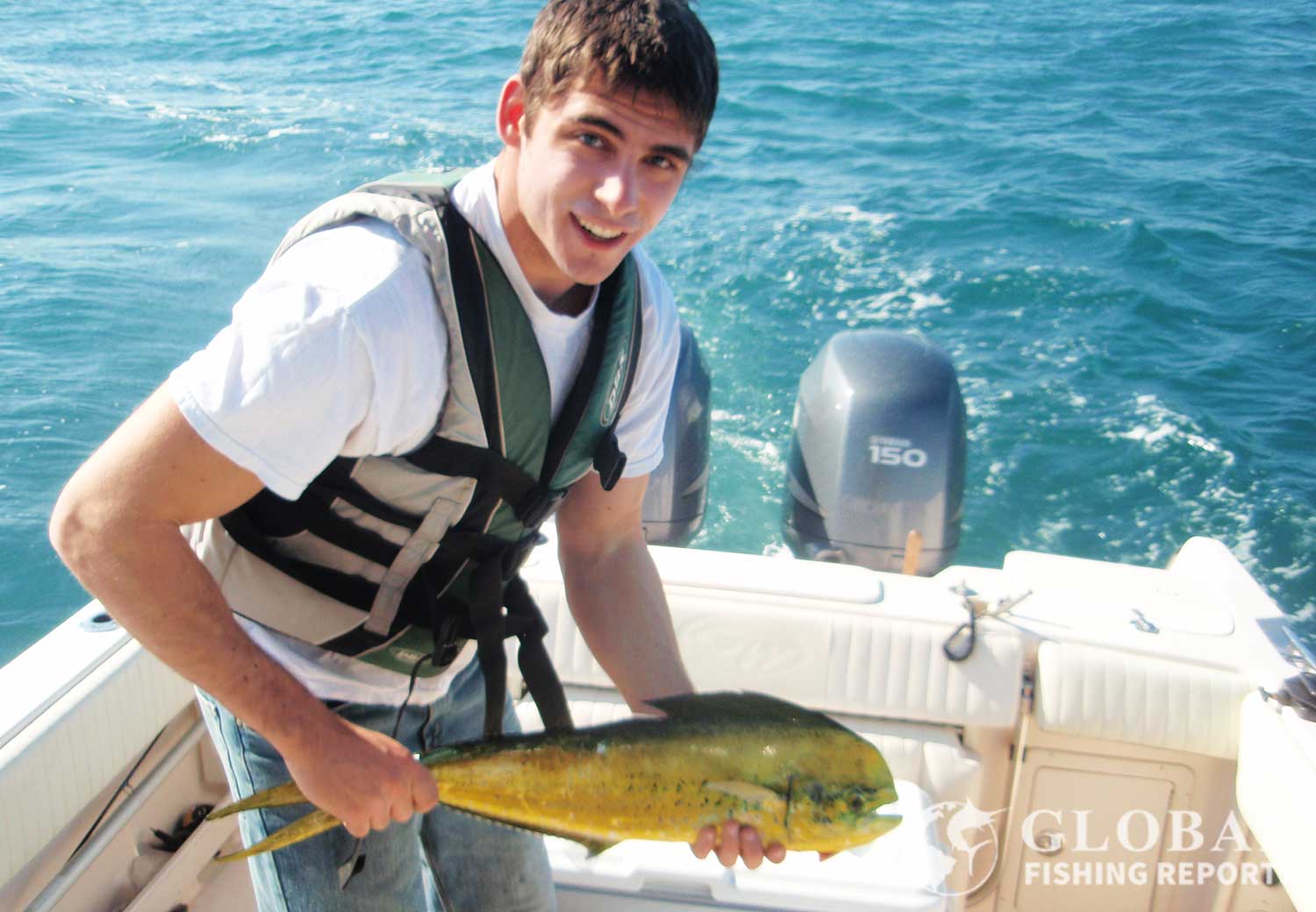
In the picture, my brother is holding a schoolie mahi-mahi. We caught a bunch of mahi-mahi that day trolling chuggers and squid baits along the edges of thick weed piles about 15 miles offshore.
8. Williamson Ballyhoo Combo
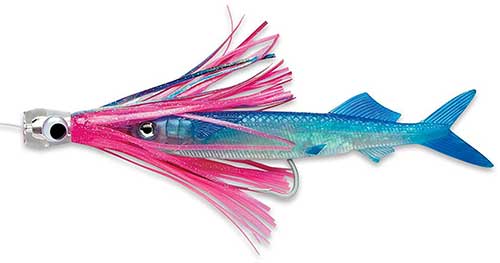
Shop Bass Pro Shops
The Williamson Ballyhoo Combo has an overall length of 10-1/2 inches and weighs 15 ounces. The lure is rigged on a 6-foot 100-pound premium sufix mono leader with VMC 9/0 hooks. The ballyhoo combo comes in color options of black-purple, bonita-blue, evil-black, Holloween blue, pink-blue, and lumo-black. The lure is a sailfish catcher that is used in combination with artificial ballyhoo.
The ballyhoo combo with artificial ballyhoo is great for recreational fisherman and is effective at attracting fish. If the dead ballyhoo is not rigged perfectly the lure can spin and fish will never bite a spinning bait. Also with dead bait, you have to deal with washout which is when the belly of the ballyhoo breaks apart which makes the bait not troll properly. This is why salt is applied to the belly of dead ballyhoo. Dead ballyhoo can also be bitten in half and then trolled for a long time without a chance of catching fish. Artificial skirted ballyhoo might not be as good as a freshly baited skirted ballyhoo but it is much easier for the recreational fisherman to use and still works great.
9. Naked Ballyhoo or Skirted Ballyhoo for Trolling
Ballyhoo Trolling Bait
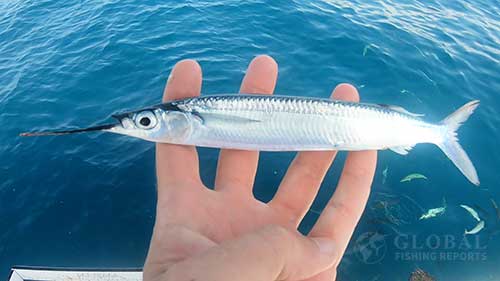
To make a ballyhoo rig for trolling start with dead ballyhoo that is fresh or that was previously frozen but thawed out. Keep the ballyhoo as cold as possible and in an ice salt brine. At a minimum salt the bellies of the ballyhoo.
Chugger Head for Skirted Ballyhoo Rig

A chugger head is a great lure to place over the dead ballyhoo to make a skirted ballyhoo rig. This adds surface action to the lure and makes the ballyhoo troll more easily in the water without spinning. The skirt also helps the belly of the bait not get washed out as quickly. Other good skirts to place over ballyhoo include the dorado catcher, sailfish catcher, and Ilander Jr.
Mustad 7/0 Hook for Ballyhoo Rig
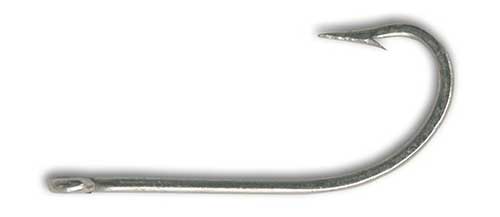
Buy from Amazon
Shop Bass Pro Shops
Mustad 3407 Classic O’Shaughnessy Forged Hooks are great for rigging ballyhoo. These hooks come in packs of 5, 50, or 100. These are the basic hooks that are used when fishing for mahi-mahi. For average size ballyhoo, a size 8/0 hook is the perfect size. When pitching ballyhoo with a spinning rod a 6/0 or 7/0 hook is a good size.
When making a ballyhoo rig for mahi-mahi 80-pound fluorocarbon leader line is used. A hook is tied to one end of the leader and the other end is tied with a perfection loop so the leader can easily be changed out. The line on the pole has a barrel snap swivel on it that can easily be connected to the perfection loop. This makes changing out baits fast when mahi-mahi are biting.
Ballyhoo Rig Copper Wire

Buy from Amazon
Shop Bass Pro Shops
This is 9-inch or 14-inch copper rigging wire. It comes with 50 copper wire strands in a clear plastic tube. Rigging wire is wrapped around the hook and then around the ballyhoo. There are many good YouTube videos about how to make a ballyhoo rig. A ballyhoo bait spring can also be used to quickly rig ballyhoo without the need for rigging wire.
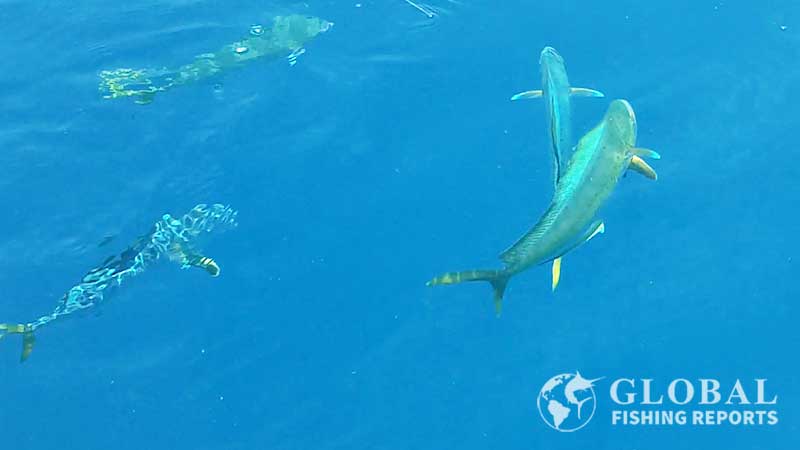
In the picture is a school of mahi-mahi about 10 miles off the coast of the Florida Keys. One fish is hooked and the other fish are staying nearby. This was in the summer and the mahi-mahi would stay close to the boat and were easily caught with pitch baits.
10. Captain’s Choice Chrome Head Mylar Skirt

Buy from Amazon
Captain’s Choice Fishing chrome head mylar skirt lures are 5-1/2 inches and weigh 5/8 of an ounce. These come in colors of black/red, blue/white, and blue/pink.
These are similar to Billy Baits Mini Turbo Slammer and Boone Turbo Slammer. A great thing is that these come rigged on a 6-foot 100-pound Ande leader line which is great for tuna which have great eyesight and tend to be leader shy. The red/black color is my go-to lure when fishing for backfin tuna in the Florida Keys. Blue/white and blue/pink are good colors for mahi-mahi. These lures work great to catch mahi-mahi but are best used when the weeds are not scattered everywhere as this style of lure will catch weeds.
11. Billy Baits Mini Turbo Slammer

Buy from Amazon
Shop Bass Pro Shops
The Billy Baits Mini Turbo Slammer is 5 ½ inches and weighs 5/8 of an ounce, the color options include pearl-pink shimmer, pink-silver, and purple-blue mylar. These come rigged on a 6 foot of 100-pound grand slam mono leader with a 7/0 Mustad hook. The rigged billy bait comes with a rubber hook protector which spaces the hook properly and offers some protection against fish with sharp teeth.
Billy baits are great to run far back in the spread. Any skittish fish that are not willing to get close to the boat can still find these trailing in the back. They are small and will catch any size fish. If there are not a lot of weeds around these work great to catch all types and sizes of offshore fish.
12. Iland Ilander Jr
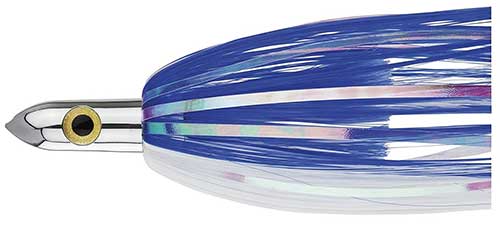
Buy from Amazon
Shop Bass Pro Shops
The Iland Ilander Jr is 6-3/4 inches weighs 1-3/4 ounces and has a bullet head. Color options include blue-white, pink-white, blue-chartreuse, and black-purple.
This lure runs well when rigged with ballyhoo. Using a ballyhoo bait spring is the fastest way to rig ballyhoo. The bait spring goes between the lure and the hook. The hook gets placed in the bottom of the ballyhoo and the spring then gets twisted on to the front of the ballyhoo which previously had its beak broken off. The blue-white and pink-white are great colors for mahi-mahi.
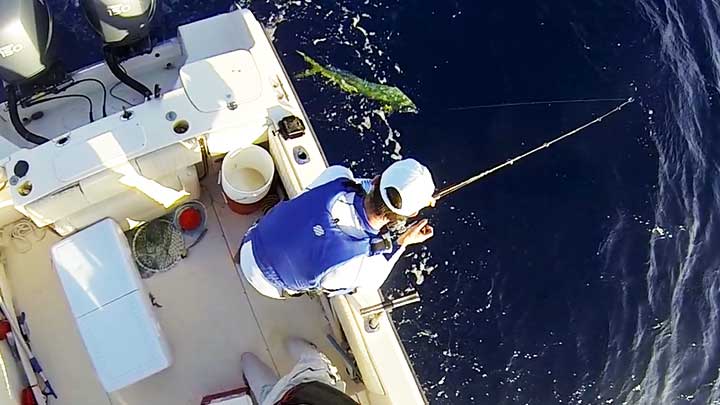
In the picture, I am reeling in mahi-mahi that was caught about 20 miles off the coast of the Florida keys. There was a good weed line and a frigate bird hovering low on our way in from fishing for tuna offshore. This was in early January and we did not see other mahi-mahi traveling with this one.
13. Williamson Big Game Catcher
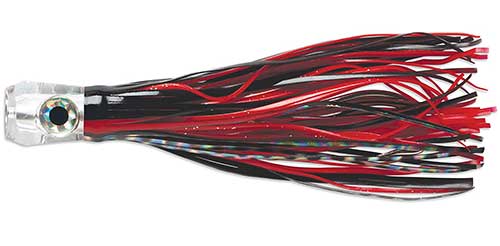
Buy from Amazon
Shop Bass Pro Shops
The Williamson big game catcher is an 8-inch lure and weighs 2-1/2 ounces. This lure comes pre-rigged on a 5-foot 175-pound test sufix leader line with a 9/0 VMC hook. Color options include blue-pink-silver, black-purple, bleeding dorado, bonito, Halloween, Lumo, pink-white, and red-black.
I like running small baits but like having at least one large 8-inch plus bait in the trolling spread. These large baits will still catch small mahi-mahi, bonito, and blackfin tuna.
Custom Rigged 8-inch Trolling Skirt Bait
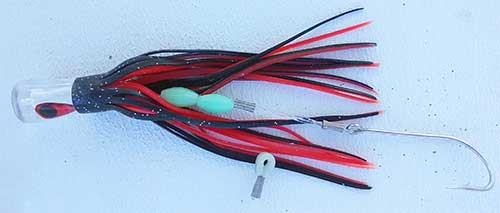
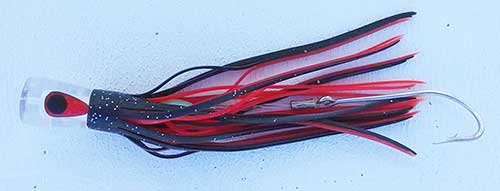
The bait rigged above is very similar to the big game catcher. Beads and crimps were used to have the hook be located just past the end of the skirt. This reduced the number of short strikes on larger baits.
14. Sea Witch on a Planer
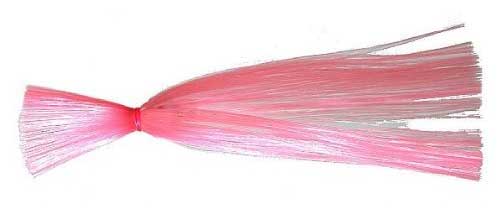
Buy from Amazon
Shop Bass Pro Shops
The sea witch comes in weights of 1/8 ounce, 1/4 ounce, 1/2 ounce, 3/4 ounce, 1 ounce, 1.5 ounces, 2.5 ounces, and 4 ounces. Color options include pink-white, blue-white, and black-purple. A 1-ounce size if good to run with a planer on a fishing pole. These should be rigged with ballyhoo. This is also a great bait for wahoo so be careful where you are running this bait without wire.
Fishing Planer Size 3
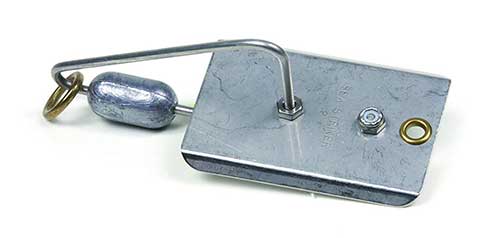
Buy from Amazon
Shop Bass Pro Shops
The Sea Strike planer comes in size 1 which runs 5-12 feet deep, size 2 which runs 10-20 feet deep, size 3 which runs 12-25 feet deep and size 4 which runs 15-30 feet deep. The size 1 corresponds to a once weight being used at the front of the planer. There is also a size 8 high-speed planer that gets tied off to the boat and acts similar to a downrigger.
I would recommend getting a size 3 or size 4 planer when using large baits. A snap swivel from the pole connects to the front metal ring. A snap swivel with a 30-50 foot leader then connects to the back of the planer. Drone spoons are typically used inshore on planners and skirted baits like sea witches are used offshore. In both cases, these are run on 30-50 class reels.
When the planer is placed in the water the metal ring slides toward the back and sets the planner pulling down. When a fish strikes the ring slide forward stopping the planer from diving. If the planer pole releases without catching a fish, raise the rod and drop it quickly to put slack in the line. This should reset the planer to dive. When a fish bites the line tension may decrease so be ready to reel in the slack like when using downriggers.
15. Rapala Magnum 30 Diving Plug

Buy from Amazon
Shop Bass Pro Shops
The Rapala x-rap 30 magnum diving plug is 6-1/2 inches in length and weighs 2.5 ounces. Good color options for mahi-mahi include hot pink, bonito, blue sardine, red-head, and silver.
When fishing offshore it is always good to have one or two lines set deep. This is often overlooked by many anglers who run all surface baits. It the fish are hanging deeper in the water the deeper baits can catch their attention. Once one fish is caught it then brings the school up near the surface baits.
The easiest way to run a line deep is with a plug that has a large diving lip. Planers, as mentioned above also work to get the bait deep. However, with planers baits need to be rigged and when a fish is caught pulling in the long leader can be a pain. Especially when there is a school of mahi-mahi behind the boat waiting to be caught.
16. Mahi-Mahi Jig

Buy from Amazon
Shop Bass Pro Shops
Shimano jigs come in a large variety of sizes. These are fast-sinking vertical jigs. For mahi-mahi a smaller 80 gram, 2-3/4 ounce is a good size since these will be used to fish the top 150 feet of water. Good color options include black anchovie, purple-silver, and pink-blue.
These jigs are a good option to drop around floating debris and thick patches of weeds. Sometimes the fish are there but are too deep for pitch baits at the surface. These jigs are also good at catching tuna and wahoo offshore.
17. Boone Rigged Feather Baits

Buy from Amazon
Shop Bass Pro Shops
Boone tuna treat feathers are 6 inches in length weigh 1-1/2 ounces. These come rigged on a 125-pound mono leader. The colors include green-yellow, blue-white, Mexican flag, red-white, purple-black, and pink-white. Bass Pro Shops has Billy Baits Ahi Slayer which is the same tuna feather style lure.
The cone shape head have reflective layers to add flash to this feather bait. Some people prefer feathers to skirted baits and these are the best looking feather baits available. These can be run empty, with strip baits or with ballyhoo.
Finding the Birds: Key to Finding Mahi-Mahi
The key to catching the first mahi-mahi of the day is finding the birds. Sometimes finding good weed lines or debris works. However, I feel much more confident that I am going to catch fish when a warbird which is also called a frigate bird is found hovering low near the water. When a low-flying frigate bird is found trolling in front of the bird while trying to directly run over the fish with the boat. Ballyhoo can be also be pitched directly underneath the frigatebird. Using binoculars or even radar can help find birds faster.
My Preferred Mahi-Mahi Trolling Setup
When trolling about four lines are typically set out. Two fill-size chuggers are typically trolled about 2o-40 feet directly behind the boat. Naked ballyhoo or skirted ballyhoo can be trolled on the outriggers if you have ballyhoo. If you do not have ballyhoo using two mini-chuggers is a great idea. A stubby bubbler, daisy chain set deep could be used. A small lure like a mini turbo slammer, little stubby, or small daisy chain should also be run straight on the back 150 feet or more. This catches any skittish fish and frequently catches tuna.
Make sure that lures do not have weeds on them at all times. You will not catch any fish if the lure has weeds on it. Sometimes the lures have to be continuously reeled in to remove the weeds. Running the lines a bit closer to the boat using lightweight lures helps to reduce the number of weeds that get caught on the line. It is better to have one lure in the water without weeds than 10 lures that all have weeds. Focus your energy on keeping the baits weed-free.
When trolling four lures are set out on 30-class conventional fishing reels. When pitching live or dead baits large spinning reels with 30-50 pound lines are. The pitch bait is usually hooked onto a 6/0 Mustad J-hook with an 80-pound fluorocarbon leader.
Once one fish is caught keep it in the water about twenty feet behind the boat until a second fish is hooked. Pitch the bait just behind the fish on the line using ballyhoo, squid, goggle eye, cigar minnow or pilchard.
Pitch Baits for Mahi-Mahi
Once you catch one mahi-mahi while trolling, it is good to see if others are following when you are reeling it in. If this is the case, stop the boat, bring in the other lines, and get ready to pitch bait with spinning rods to the school of fish. This approach can quickly allow you to go from catching a single fish to potentially catching your limit in a short period of time. See the article on “Pitch Bait for Mahi-Mahi” for more information on this effective technique.
Common Questions About Mahi-Mahi Fishing
How fast do you troll for mahi-mahi?
The best speed to troll for mahi-mahi is 5-8 knots when using baits with ballyhoo and 7-10 knots when using lures without ballyhoo. If I was just going to tell someone one speed to troll, it would be 8 knots, which is about 9 miles per hour. In reality, it is best to look at the lures and see what they look like. They should be splashing on the surface and going beneath the water. The lures should never be tumbling. Also, make sure they do not have weeds on them. Going faster and keeping lines close helps them stay weed-free. Often, troll speed is referred to by the RPMs of the boat. We go 2100 RPM, for example. Sometimes a small change in RPMs allows the lures to be more visible relative to the boat wake.
What depth do you catch mahi-mahi?
Mahi-mahi are most commonly caught on the surface near surface structure. The fish can be down 100-plus feet depending on the conditions, but fishing lines are rarely set below 50 feet when fishing for mahi-mahi. It is a good idea to have a deep-diving plug or baited skirt on a planer to draw any deeper schools of mahi-mahi to the surface.
The overall depth of water where mahi-mahi are found ranges from 100 feet to 30,000 feet. If there is no surface structure, mahi-mahi are typically found near temperature breaks where currents come together and ledges where upwelling currents can bring nutrient-rich plankton and baitfish to the surface. The predator fish like mahi-mahi are attracted to these areas because of the baitfish.
How far behind the boat should I troll?
A typical offshore trolling spread has lines set at three distances behind the boat. One line is set close, about 25 feet behind the boat, basically right in the prop wash. This line is easy to keep weed-free, and mahi-mahi can be attracted by the prop wash and find this bait. Two lines should be sent midway back off the sides of the boat with outriggers if available. These are typically set 90-150 feet back.
The fourth rod should be sent straight out the back and is called the shotgun rod. It is typically set 200-250 feet behind the boat. A small daisy chain is a great option for the shotgun position. A fifth line should be set not for distance but for depth. A deep-diving plug or planer should be used to get a line 15-30 feet below the surface. This line is typically set about 75 feet behind the boat.
Where do you fish for mahi-mahi?
Mahi-mahi are fish that are found offshore near the Gulf Stream in the Atlantic Ocean. Mahi-mahi are also found offshore of California, Mexico, and Central America in the Pacific Ocean. However, mahi-mahi are commonly called dolphin or dorado on the west coast. Mahi-mahi seasonally migrate thousands of miles each year and typically spawn in waters around 83 degrees. Mahi-mahi season in Florida goes from late spring until the end of summer. Some smaller mahi-mahi can be caught year-round around good offshore structure.
What is the best bait for mahi-mahi?
The best live baits for mahi-mahi are goggle eyes, cigar minnows, ballyhoo, pilchards, and scaled sardines. The best dead baits for mahi-mahi are ballyhoo, squid, bonito chunks, and shrimp. Lures that are the best for mahi-mahi include chuggers, stubby bubblers, and daisy chains.
Are dolphin fish and mahi-mahi the same thing?
In most cases, dolphin fish, dorado, and mahi-mahi are the same type of fish species. There is a pompano dolphinfish that is found in Central America that is commonly mistaken for small mahi-mahi. These are the only two fish that are in the Coryphaena genus. It is also important to note that a dolphin fish is different than a porpoise dolphin. When you tell someone that you want dolphin for dinner, they often look at you with an evil grin. That is when you have to tell them you are not talking about Flipper.
Is mahi-mahi fish good for you?
Mahi-mahi is a high-protein food that is full of essential amino acids and enzymes such as omega-3 fatty acids, vitamin B, potassium, selenium, and iron.
Mahi-mahi is considered a lower mercury fish. These are the fastest-growing fish in the world and typically live for four years. This means there is less time for mercury and heavy metals to build up in the fish. Mahi-mahi also live far offshore away from nearshore pollution. Personally, I think this is a very safe fish to eat, with mahi-mahi and small blackfin tuna being my favorite fish to eat.
Captain Cody has worked on charter fishing boats in the Florida Keys, Virgin Islands, and Alaska. Growing up in Pennsylvania Cody has also done extensive freshwater fishing including bass fishing tournaments. Cody strives to provide detailed information about the best fishing gear and tactics to help both novice and experienced anglers have a more productive and enjoyable time on the water. Cody also has a background in aerospace engineering and neuroscience but really only takes pride in being good at one thing and that is fishing!


























































































































Please help find a super blue fin lure made by Sansui. It is 470 grams glow in the dark and this lure was used by fishermen last week on the fishing boat Tomahawk. It was fishing out of Fishermen’s Landing San Diego, have tried to purchase everywhere but no luck.
Thank You,
Chuck Barnett